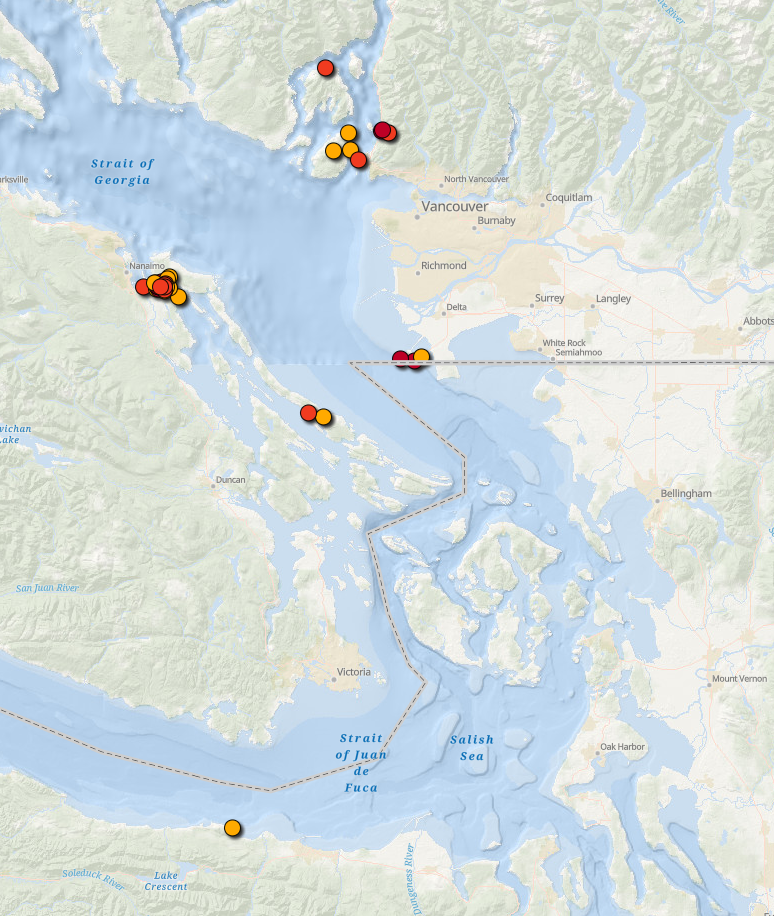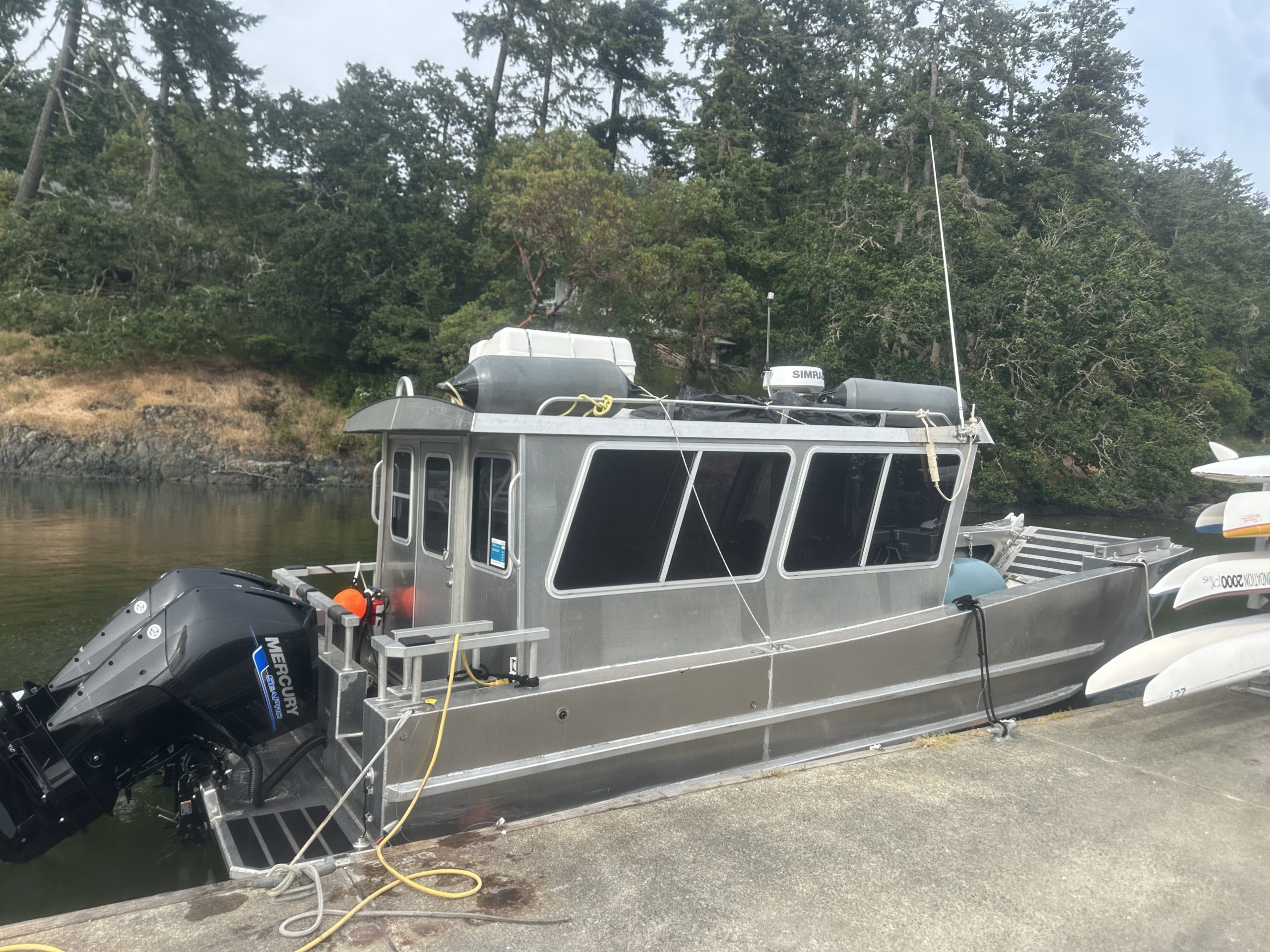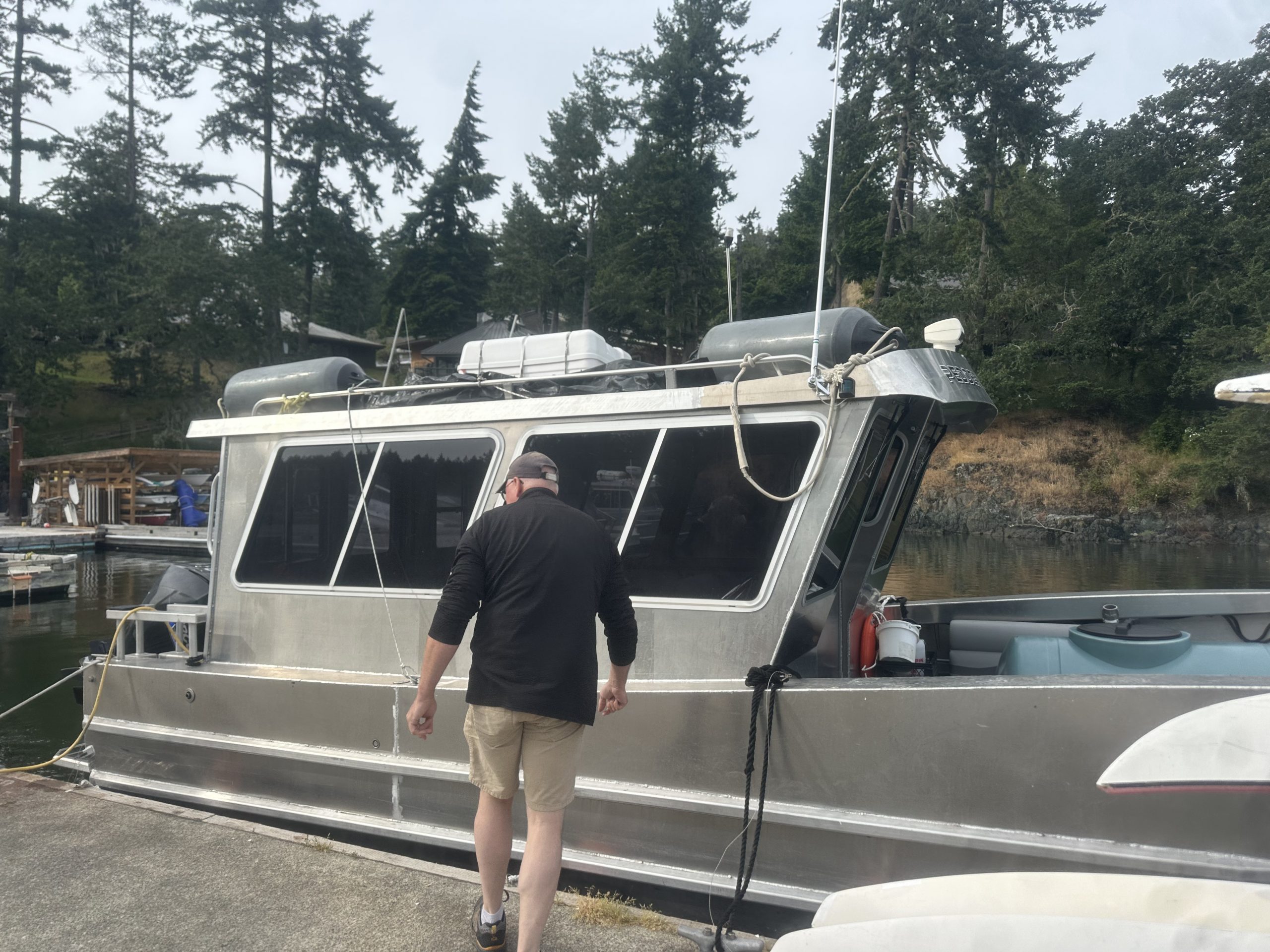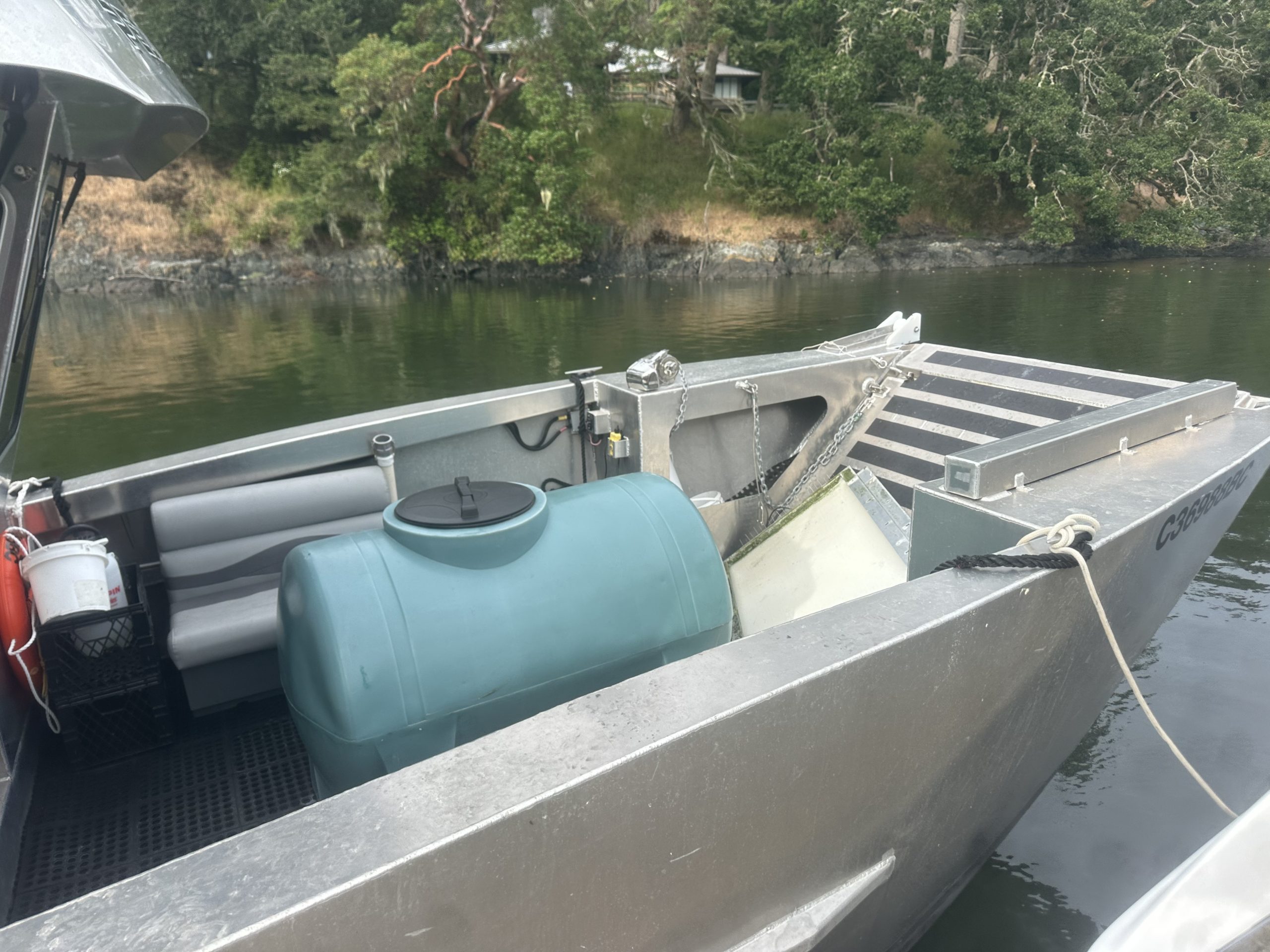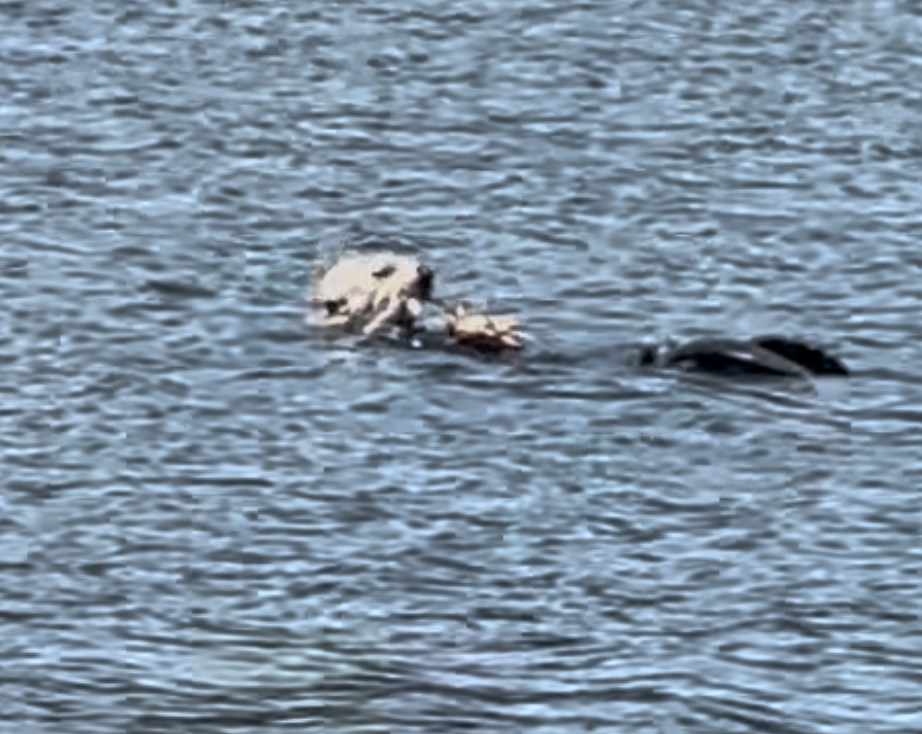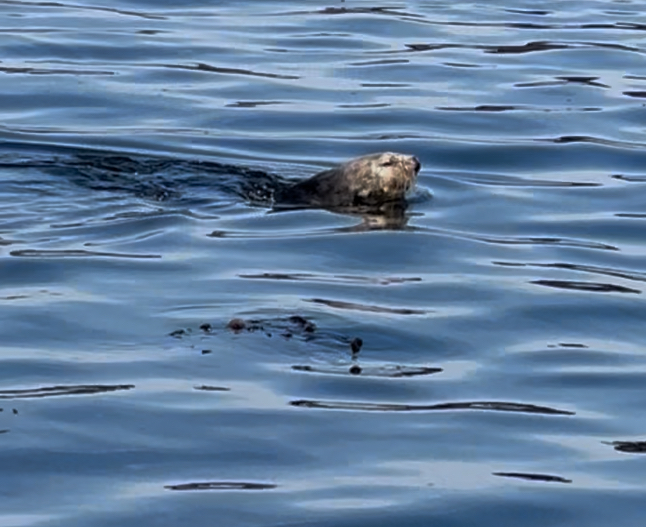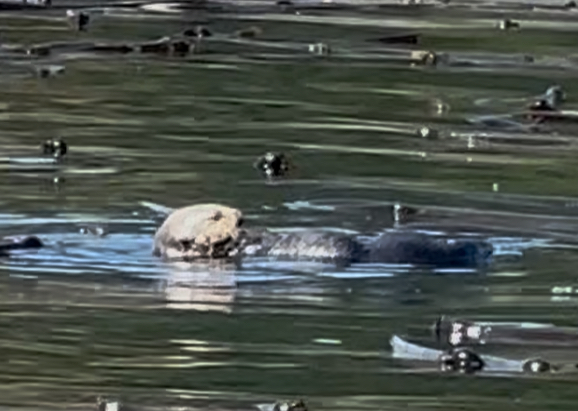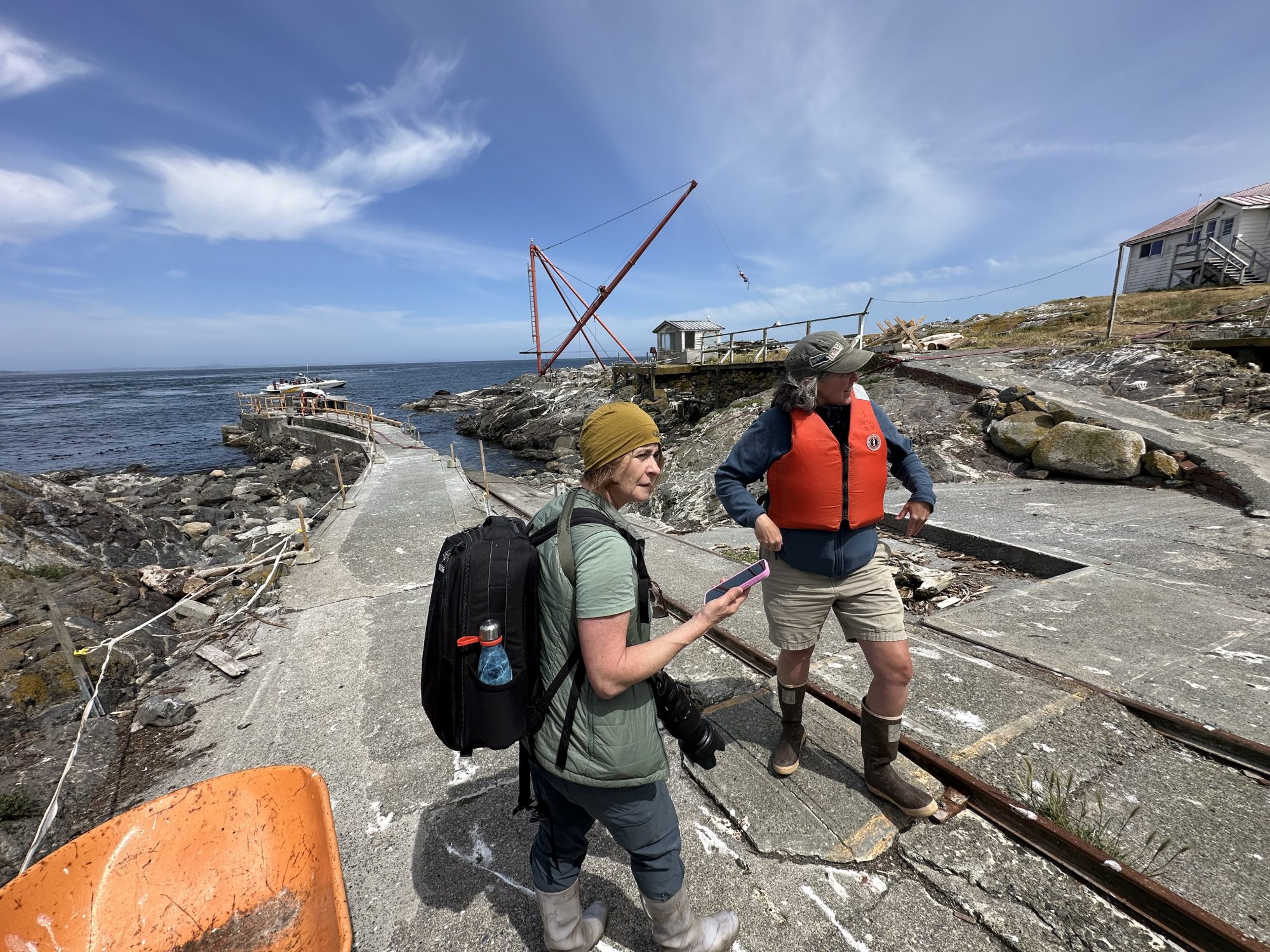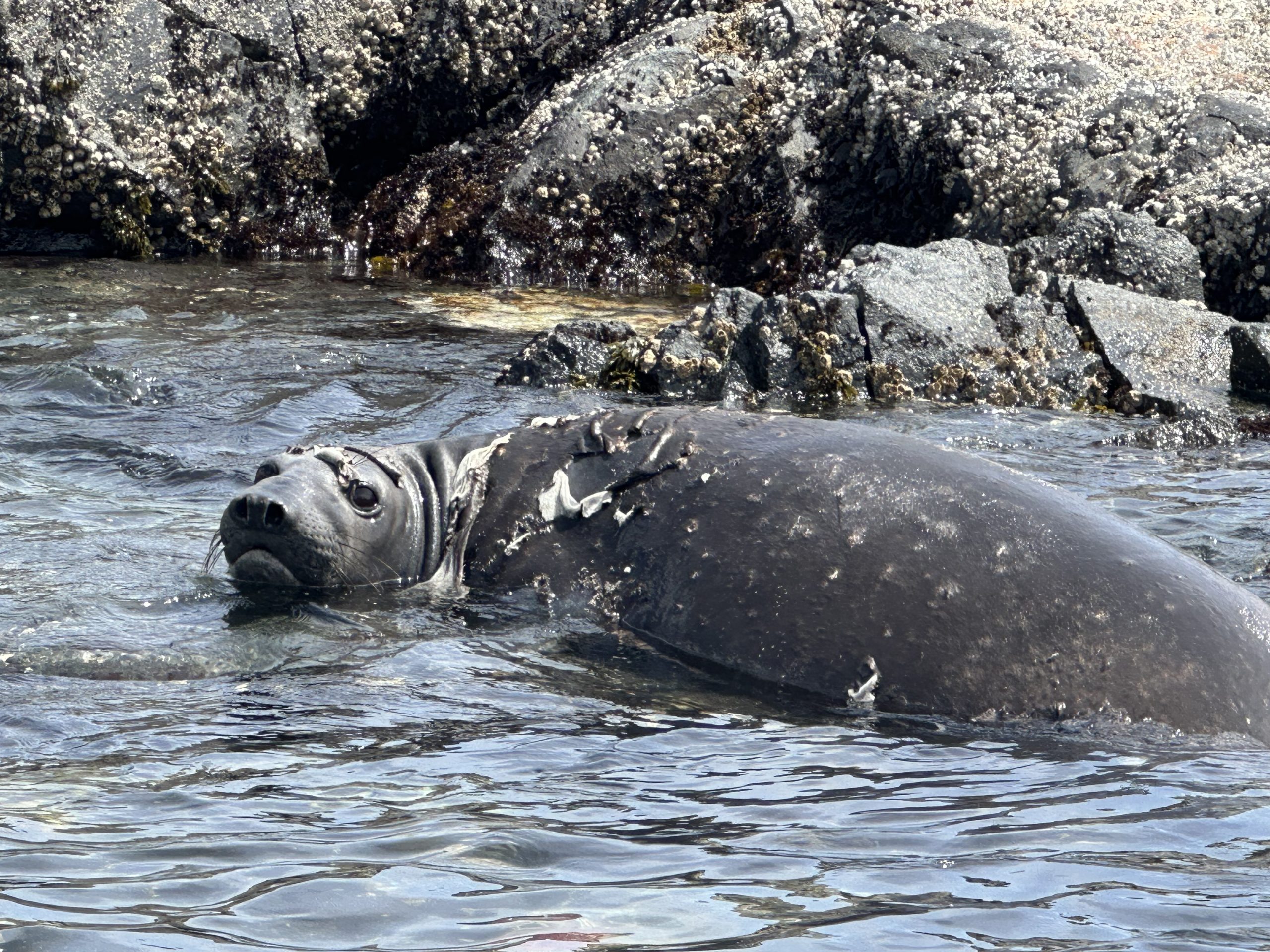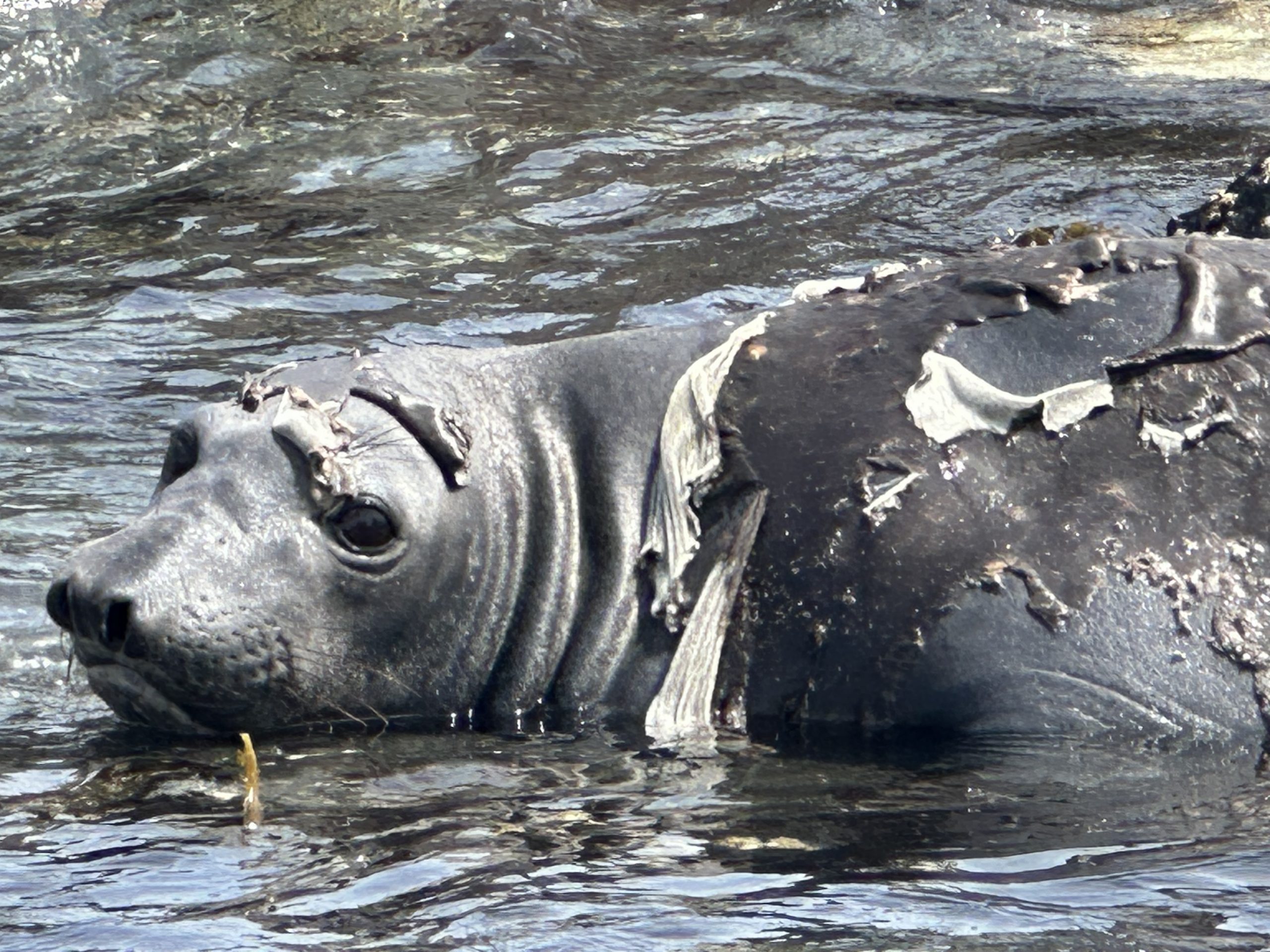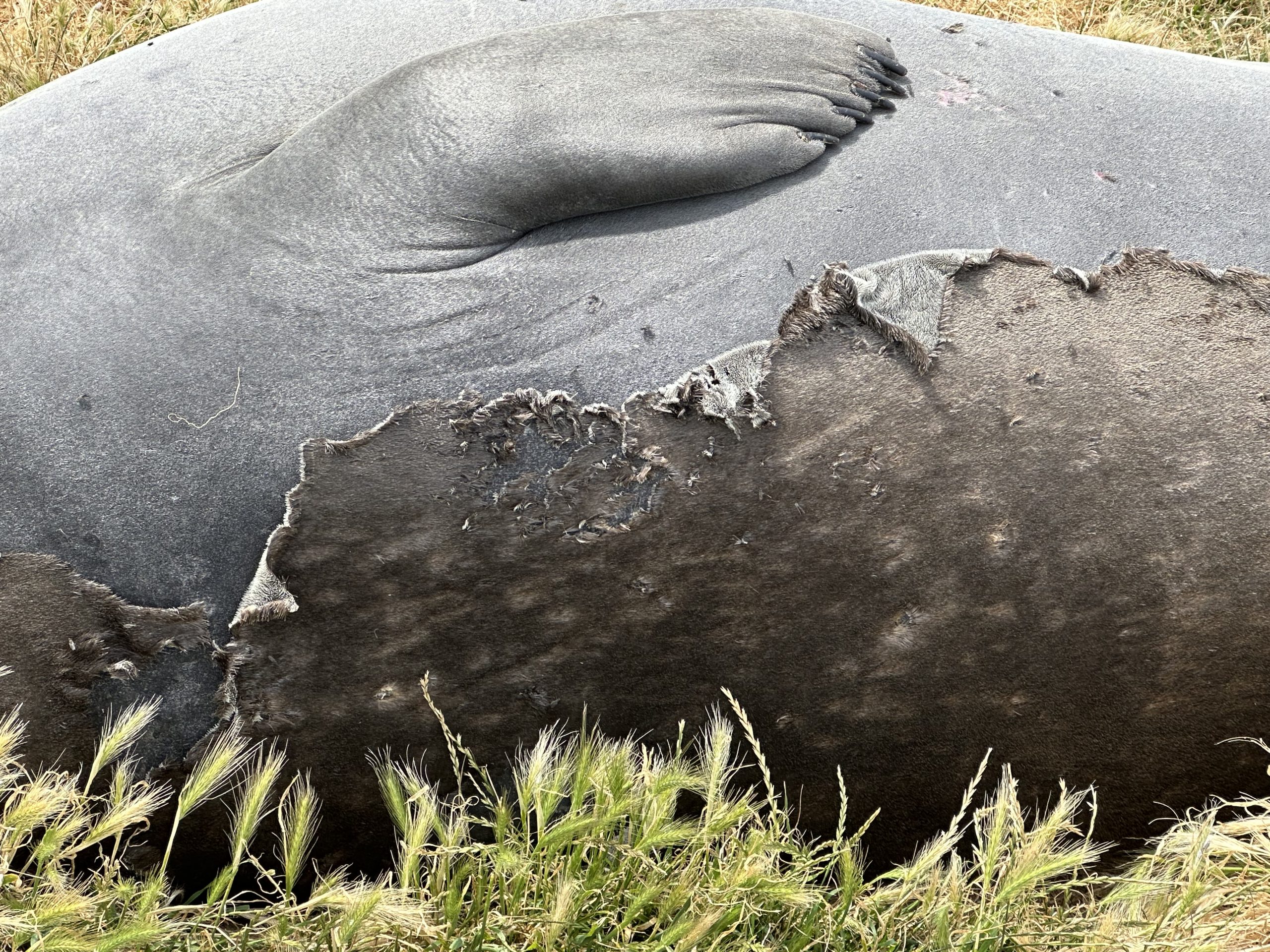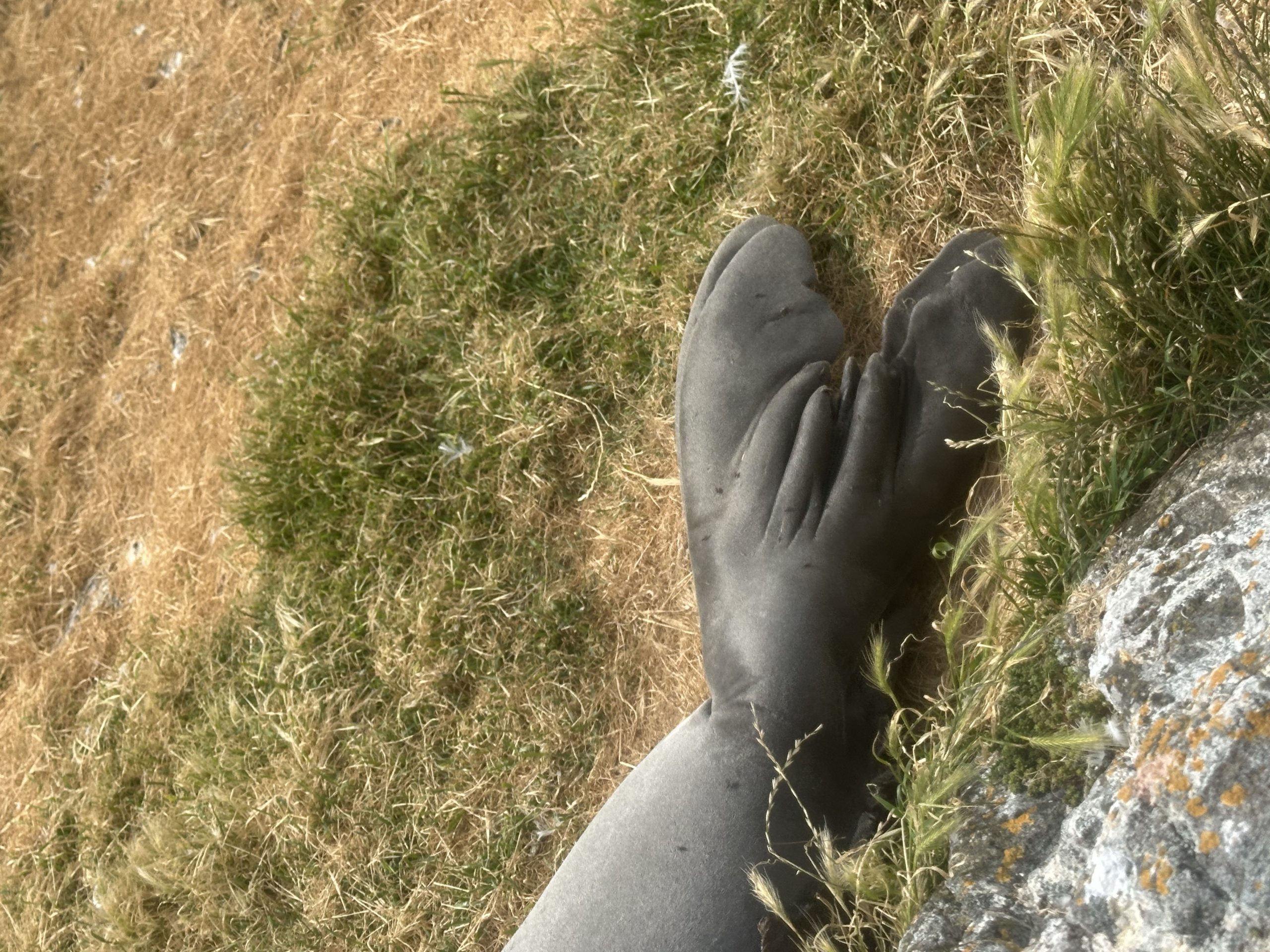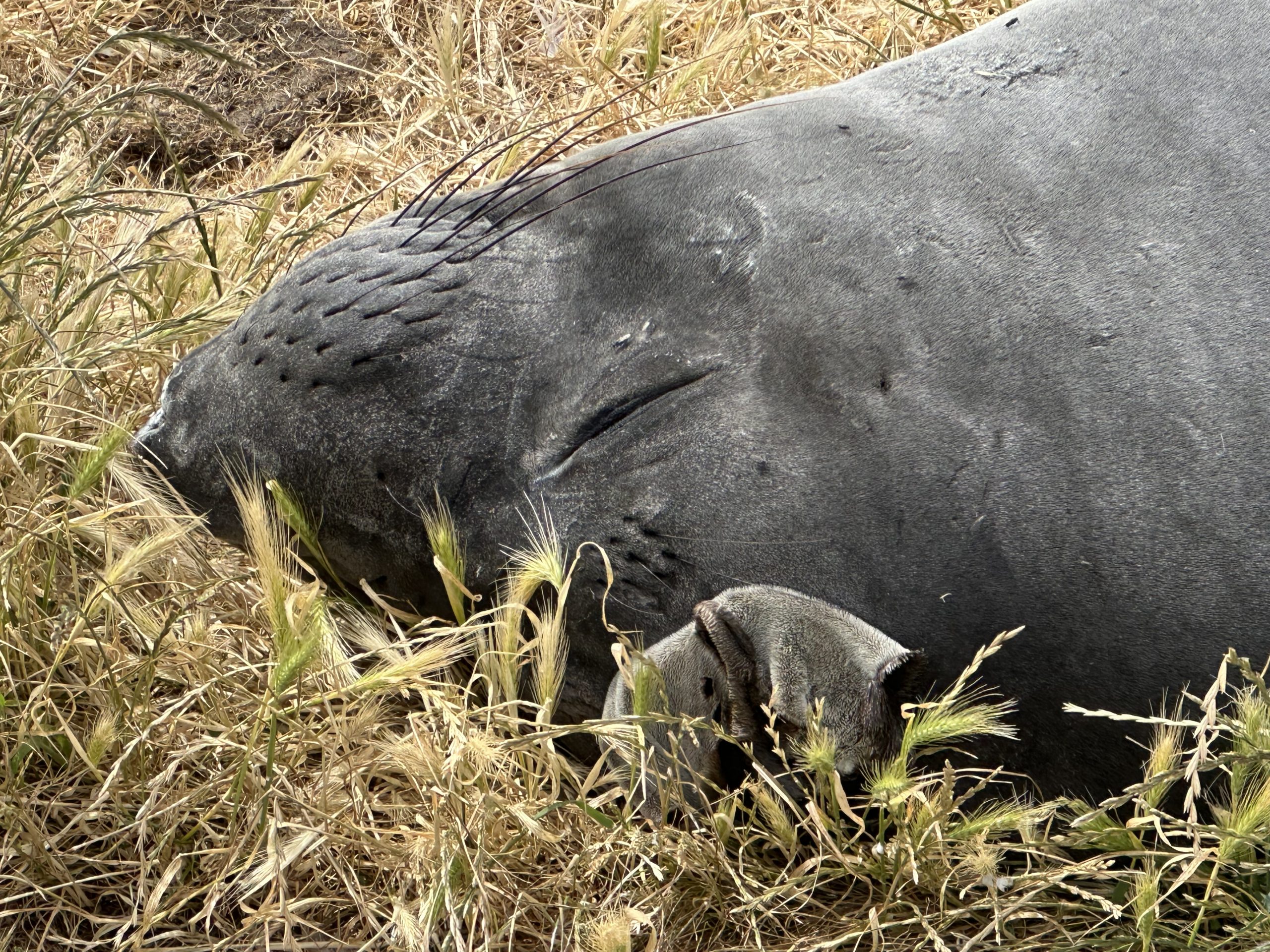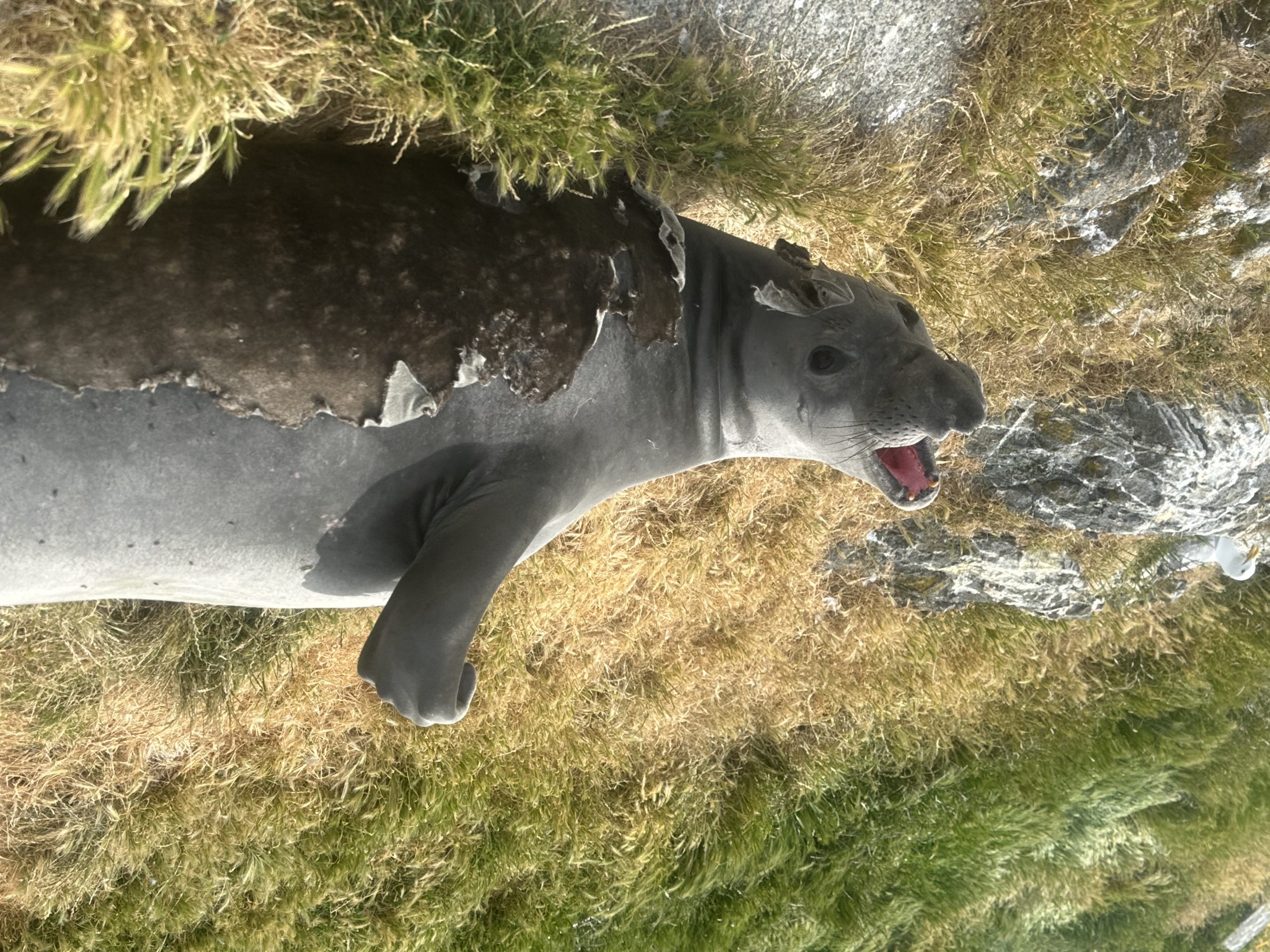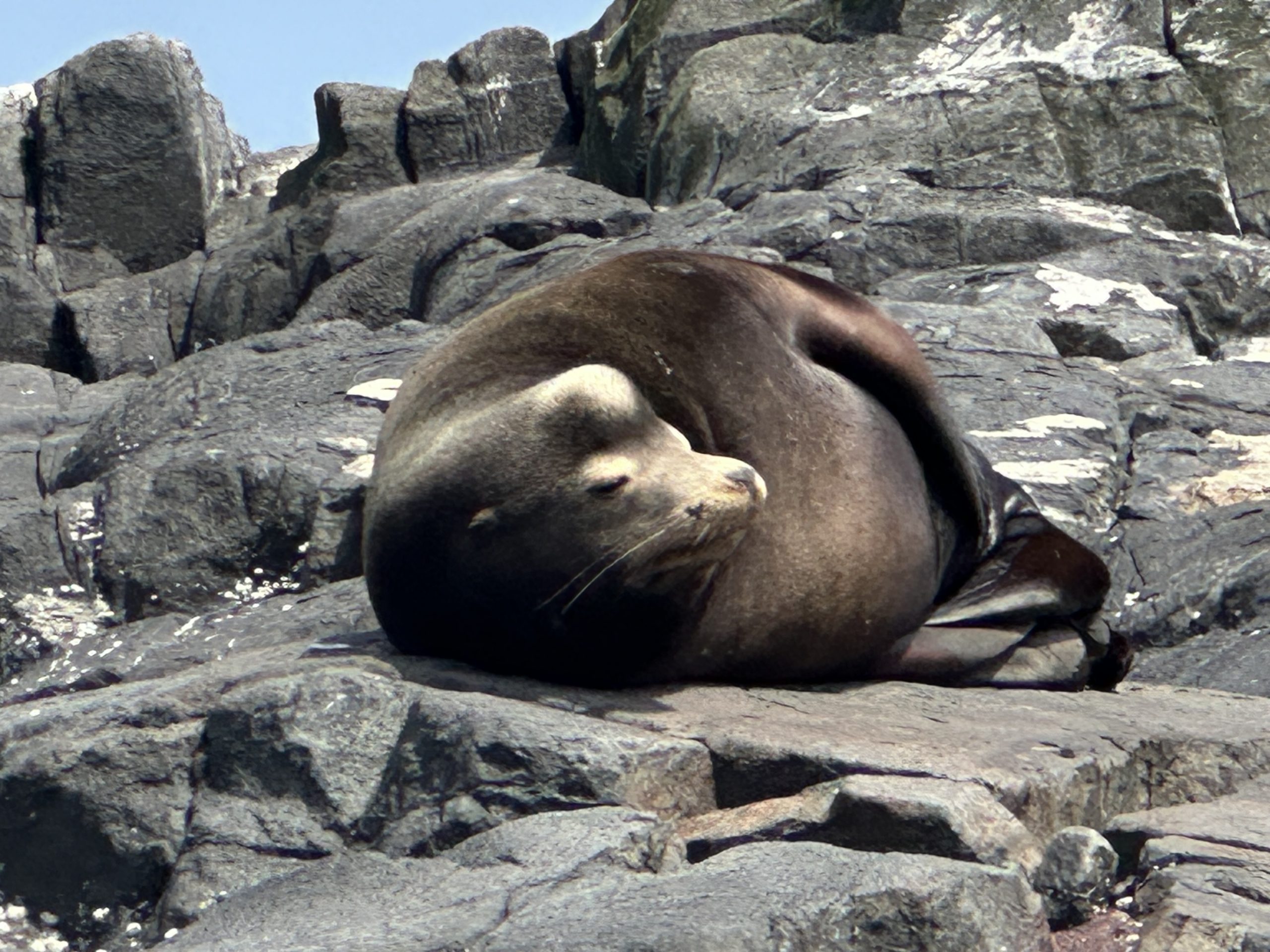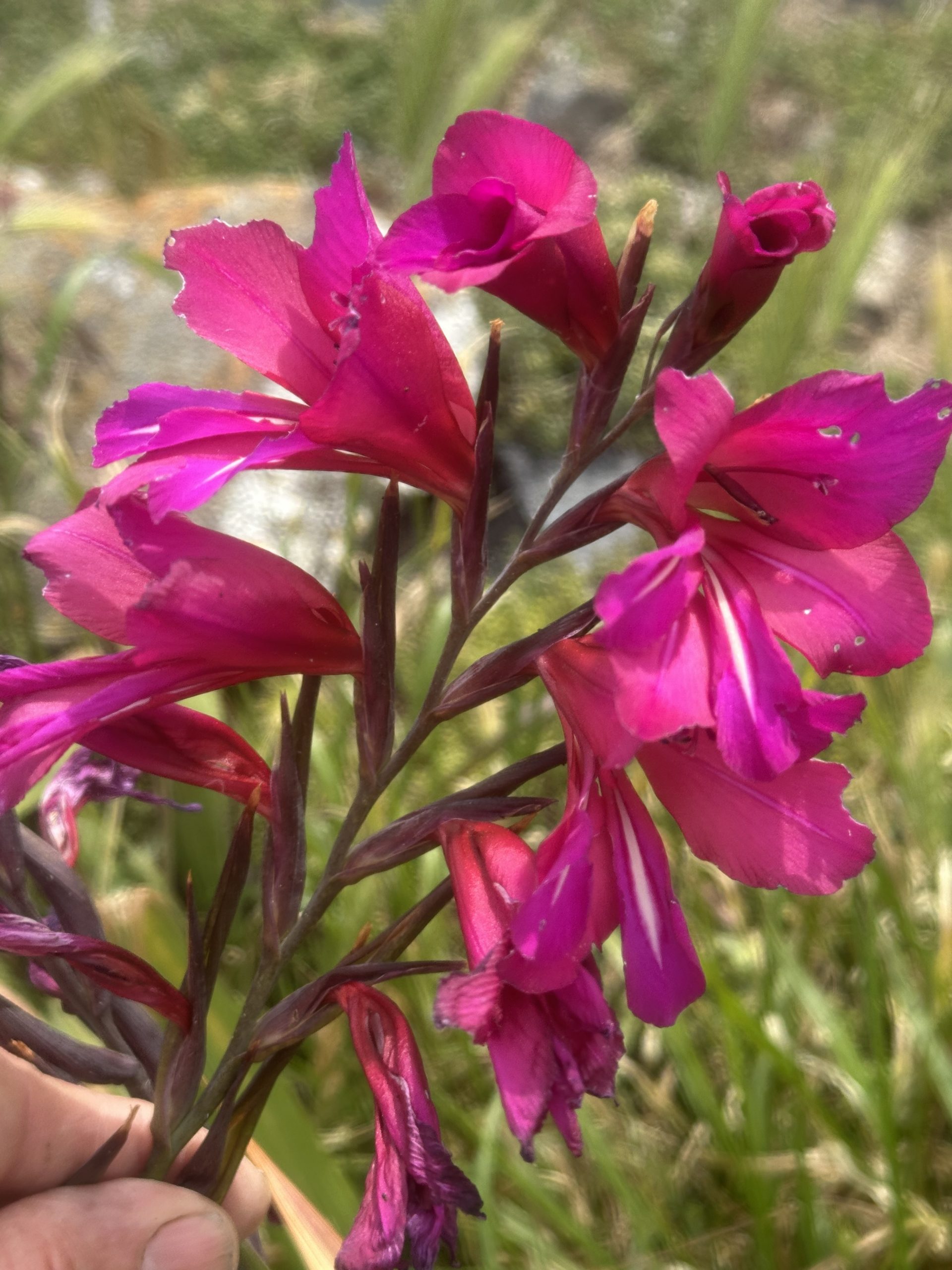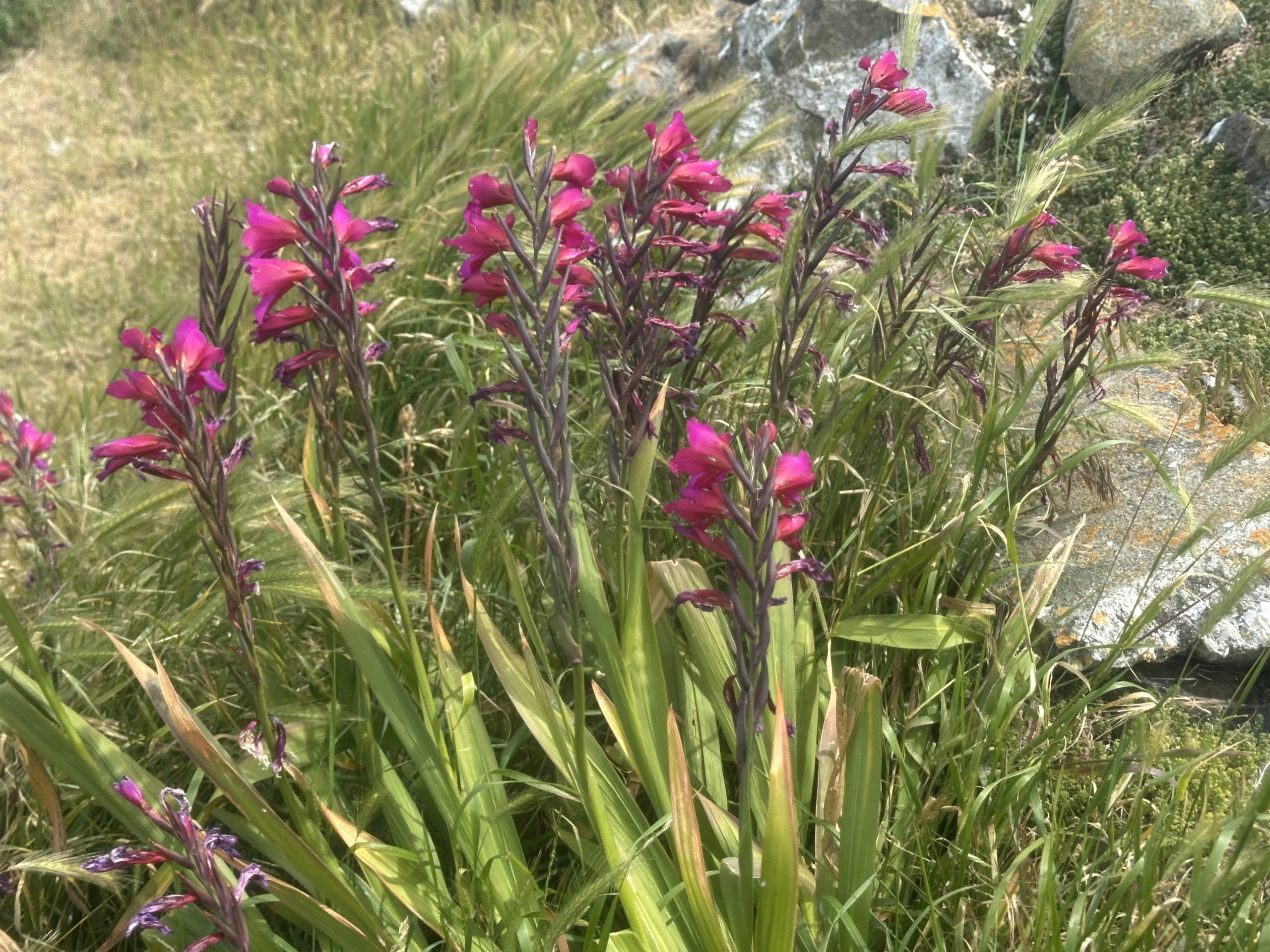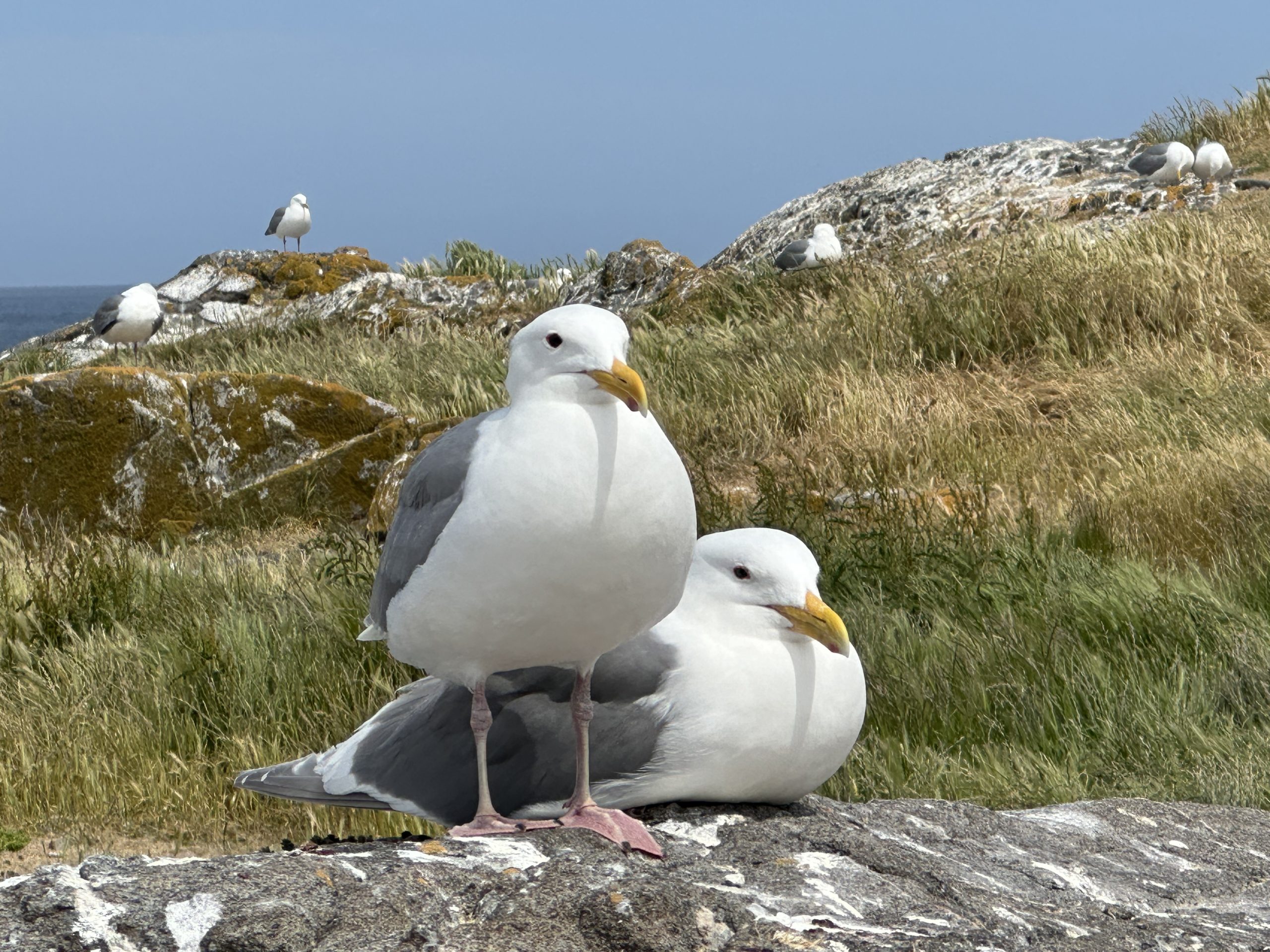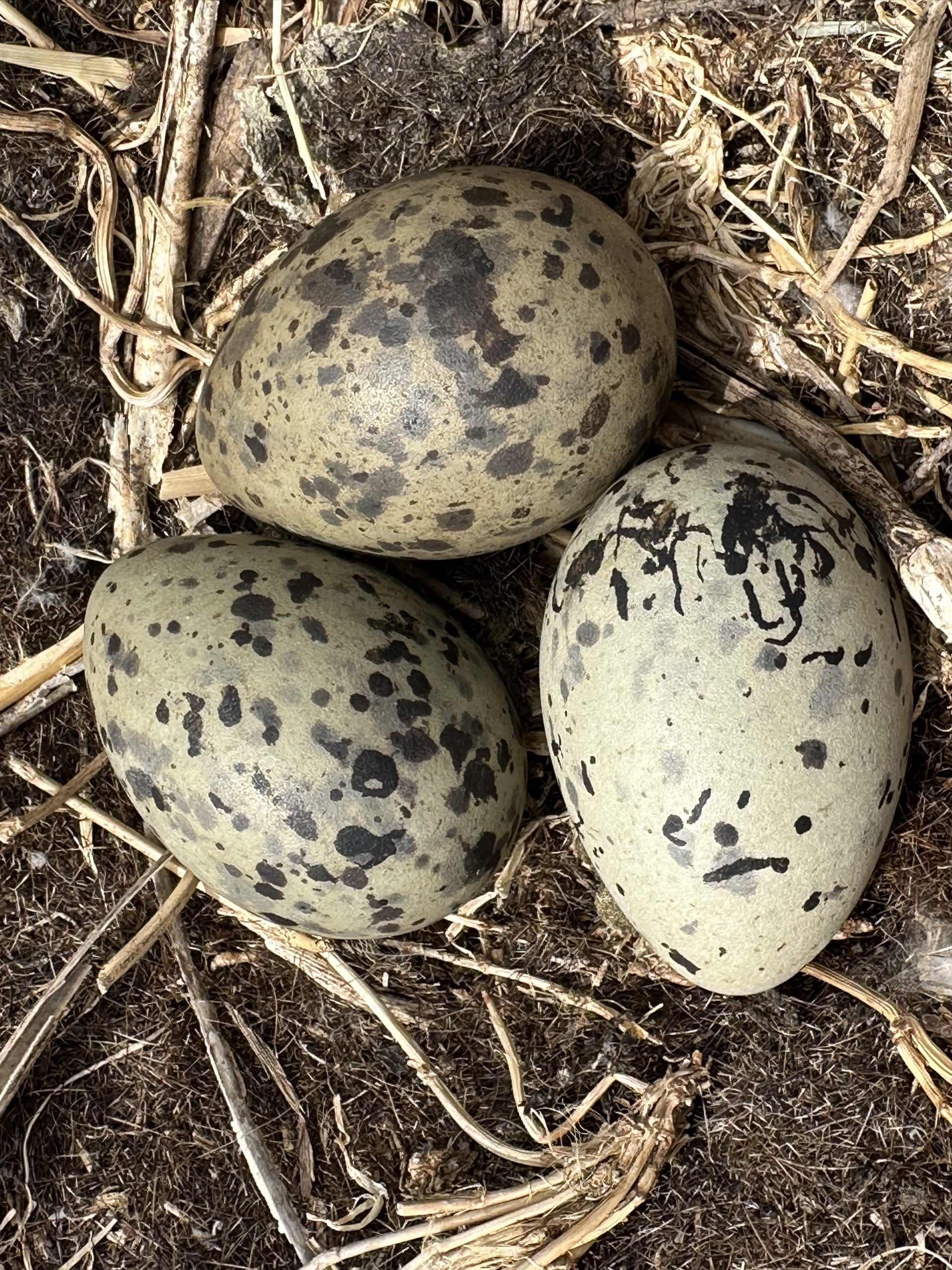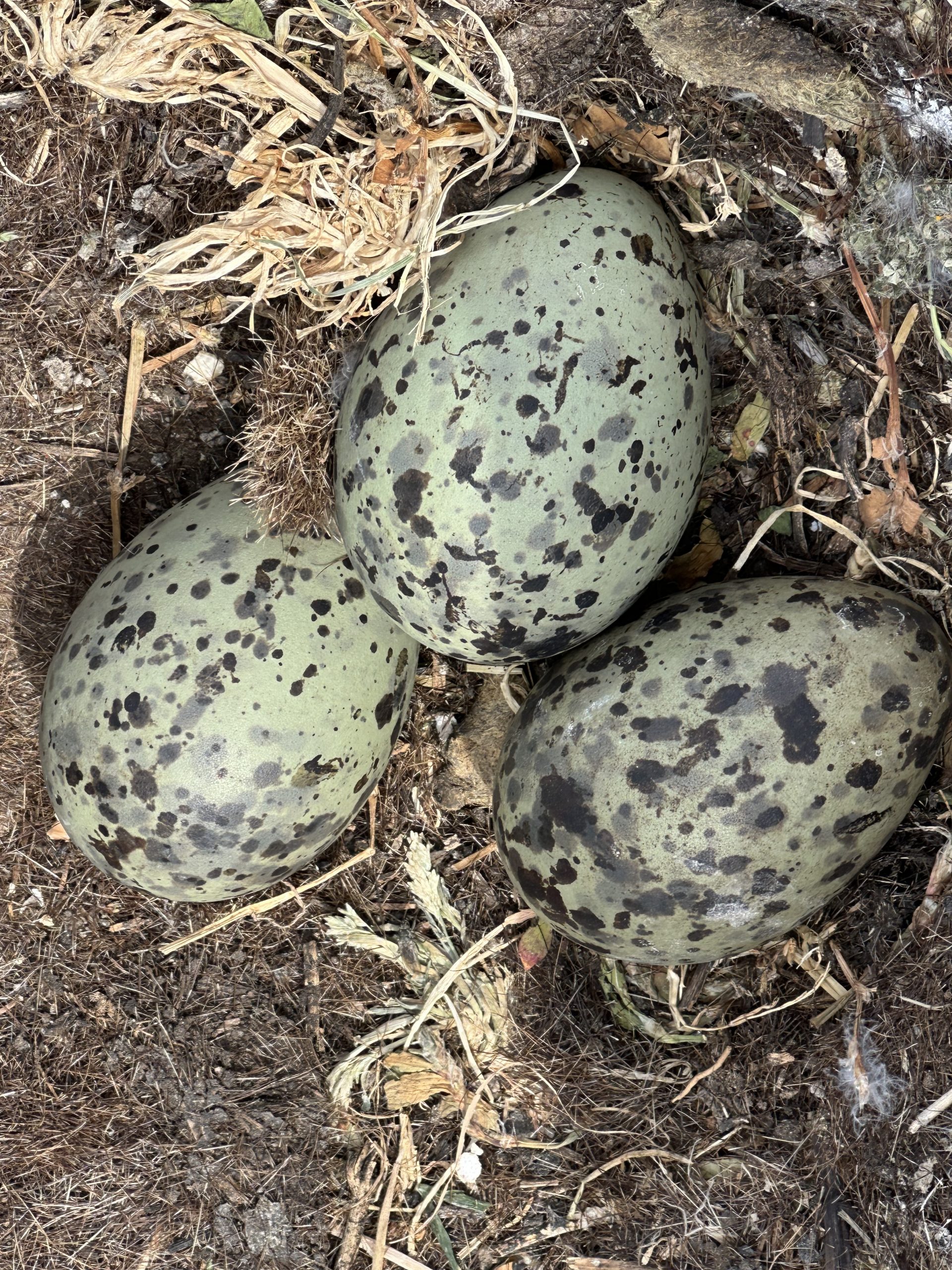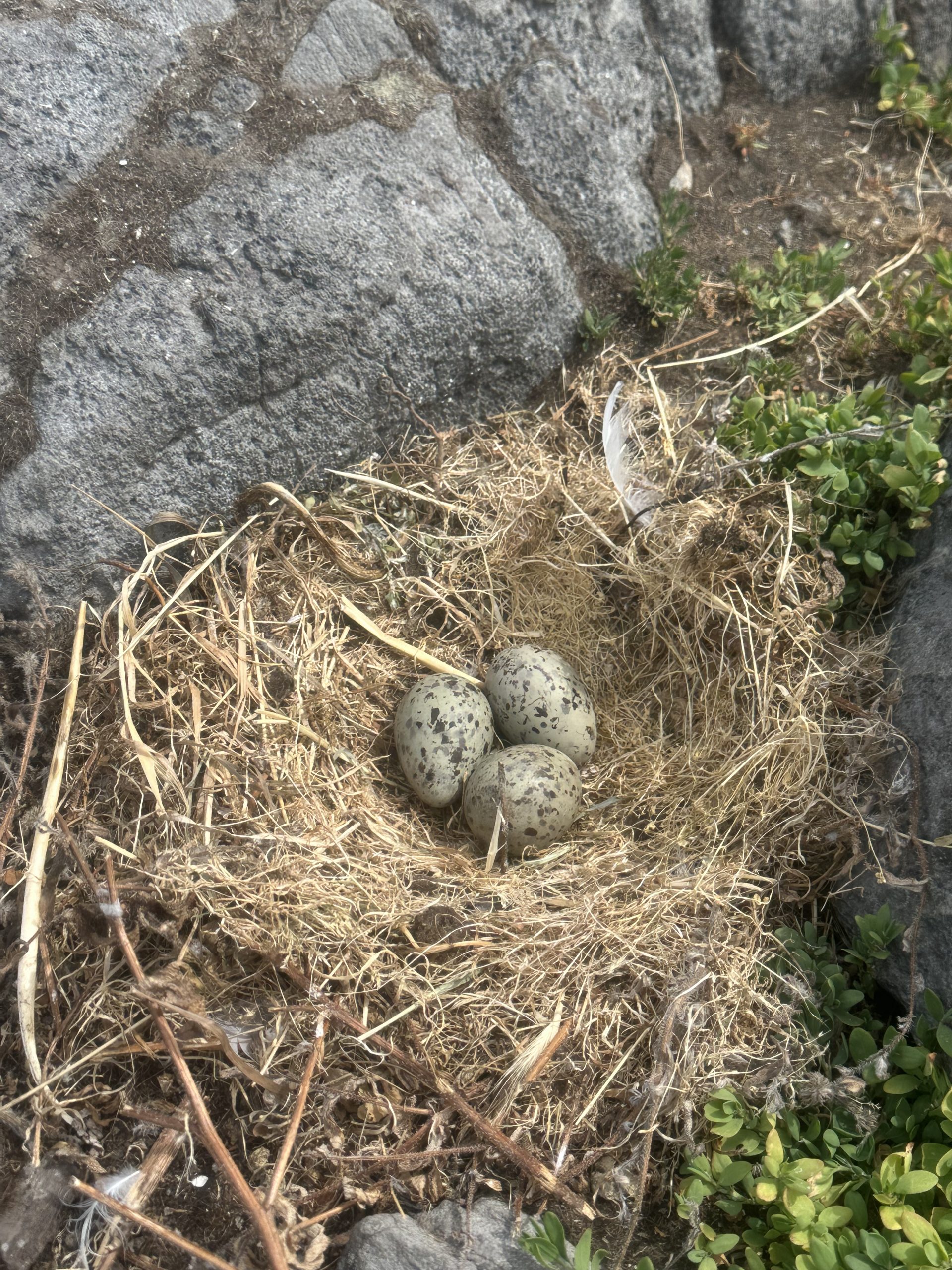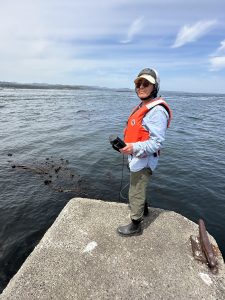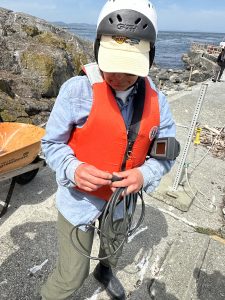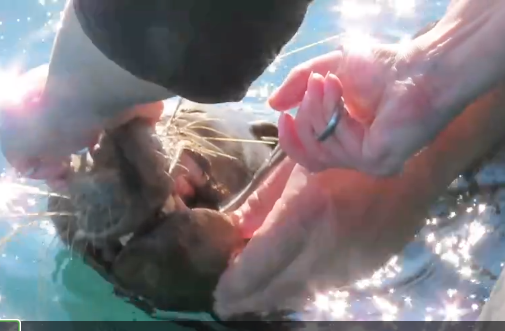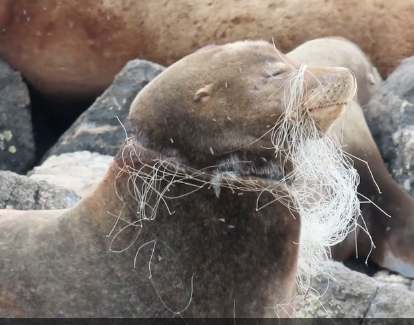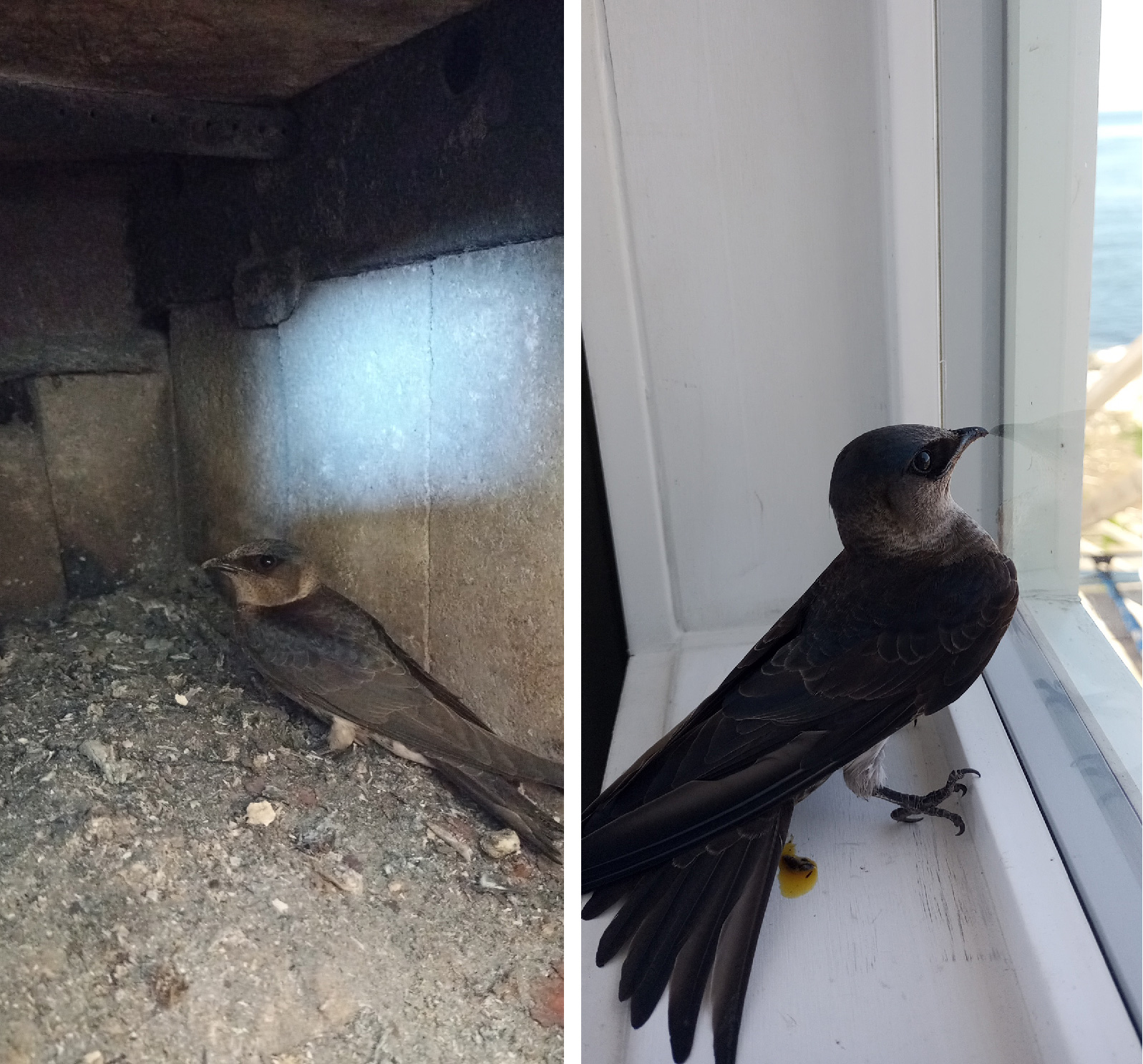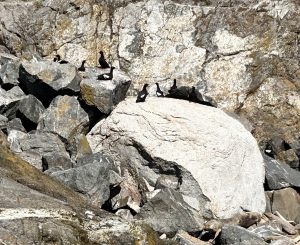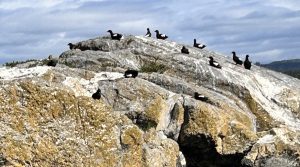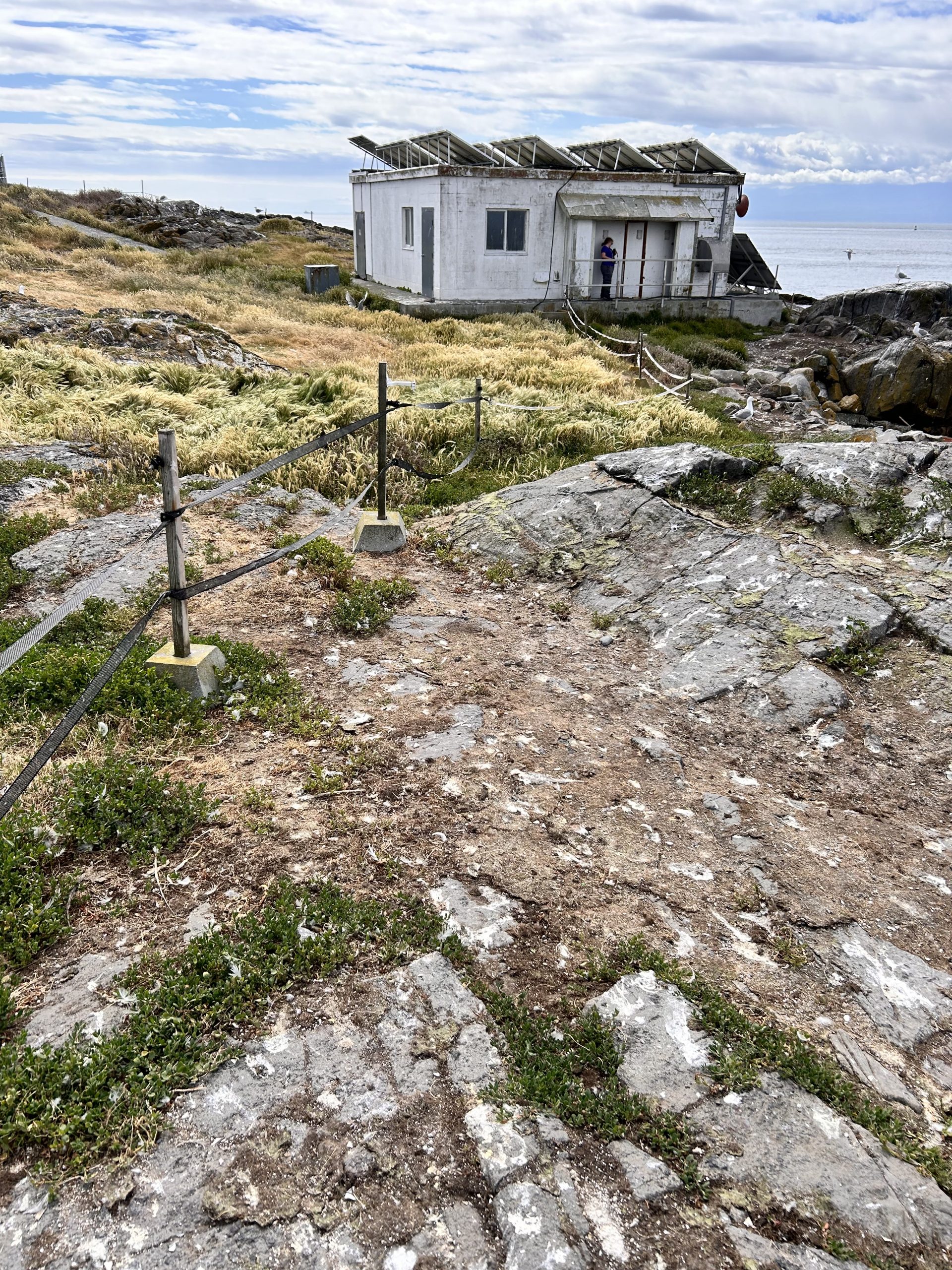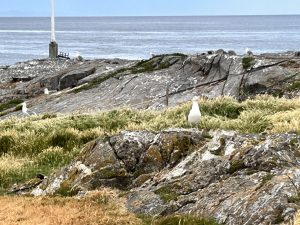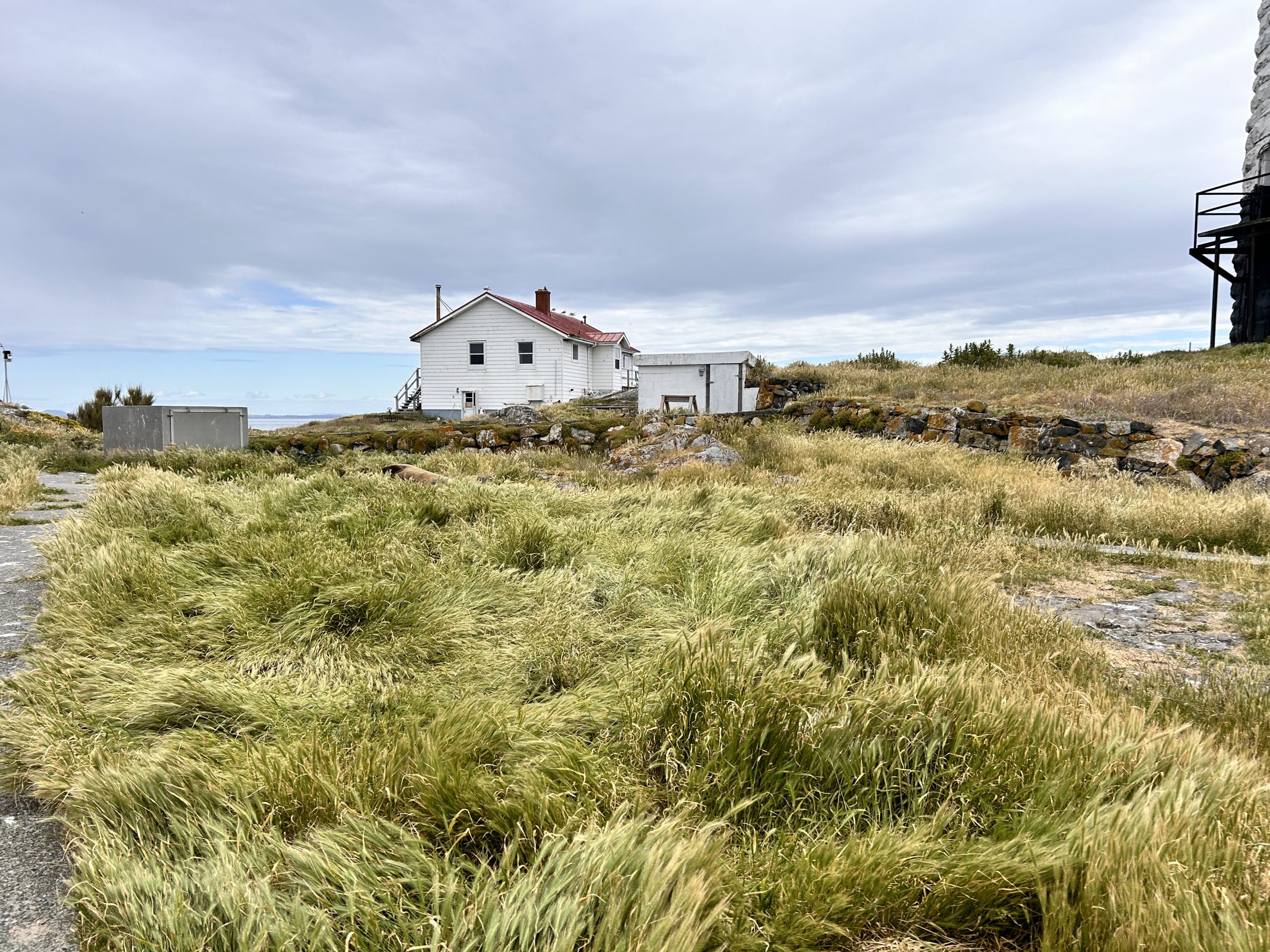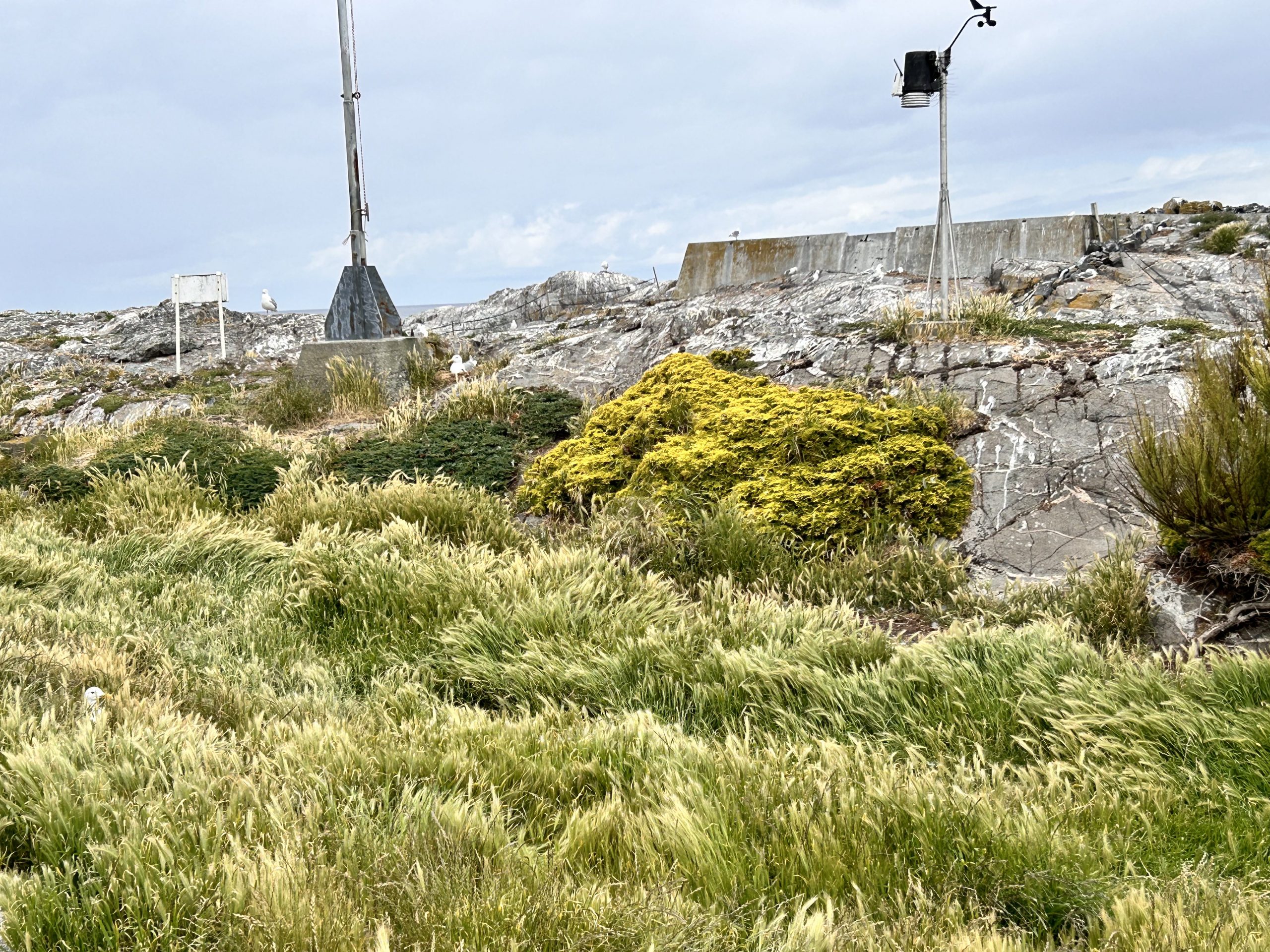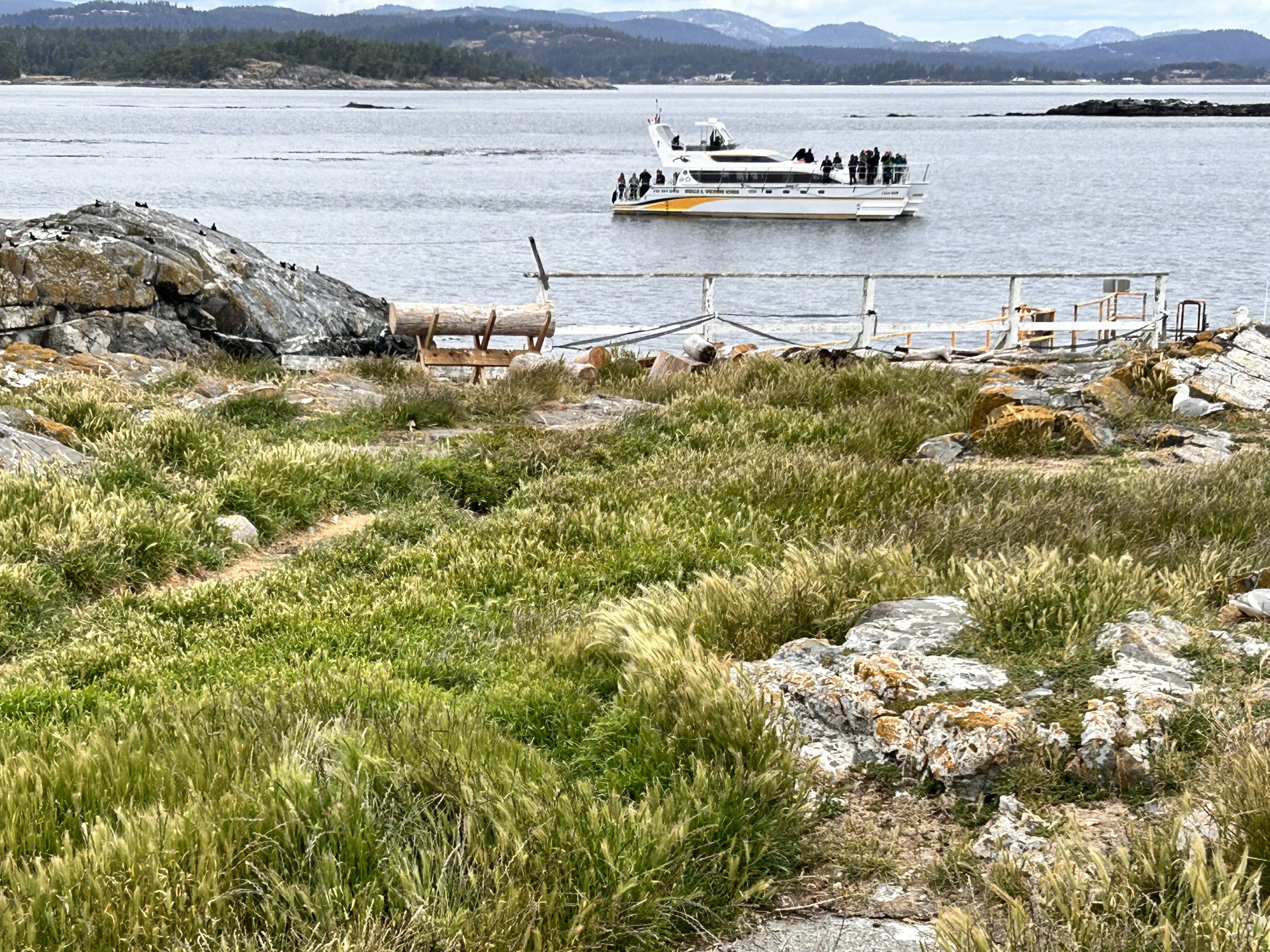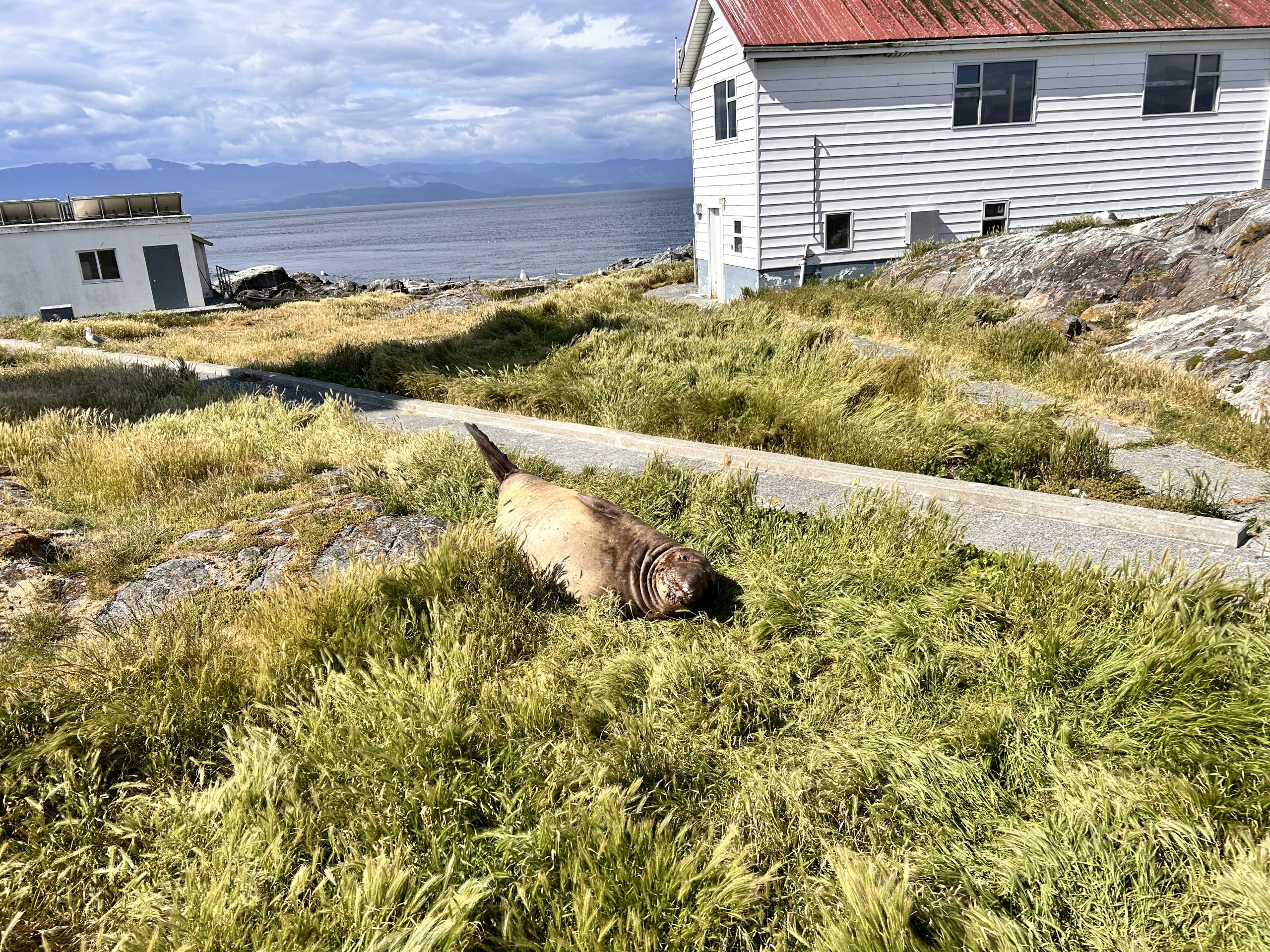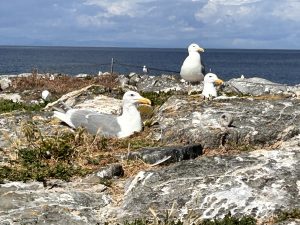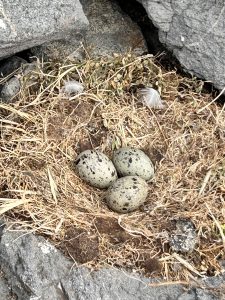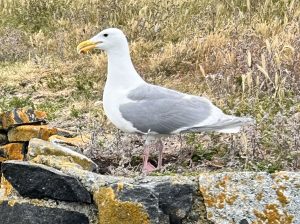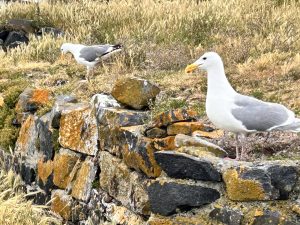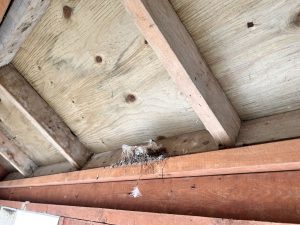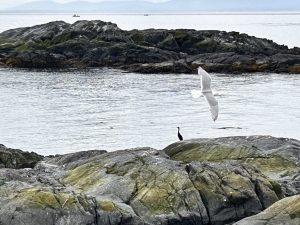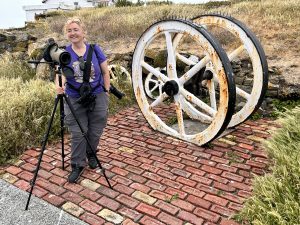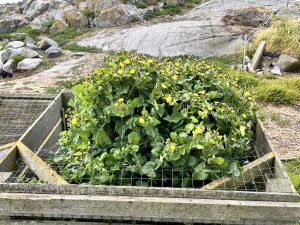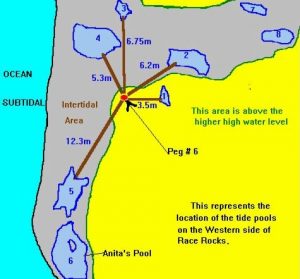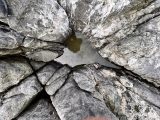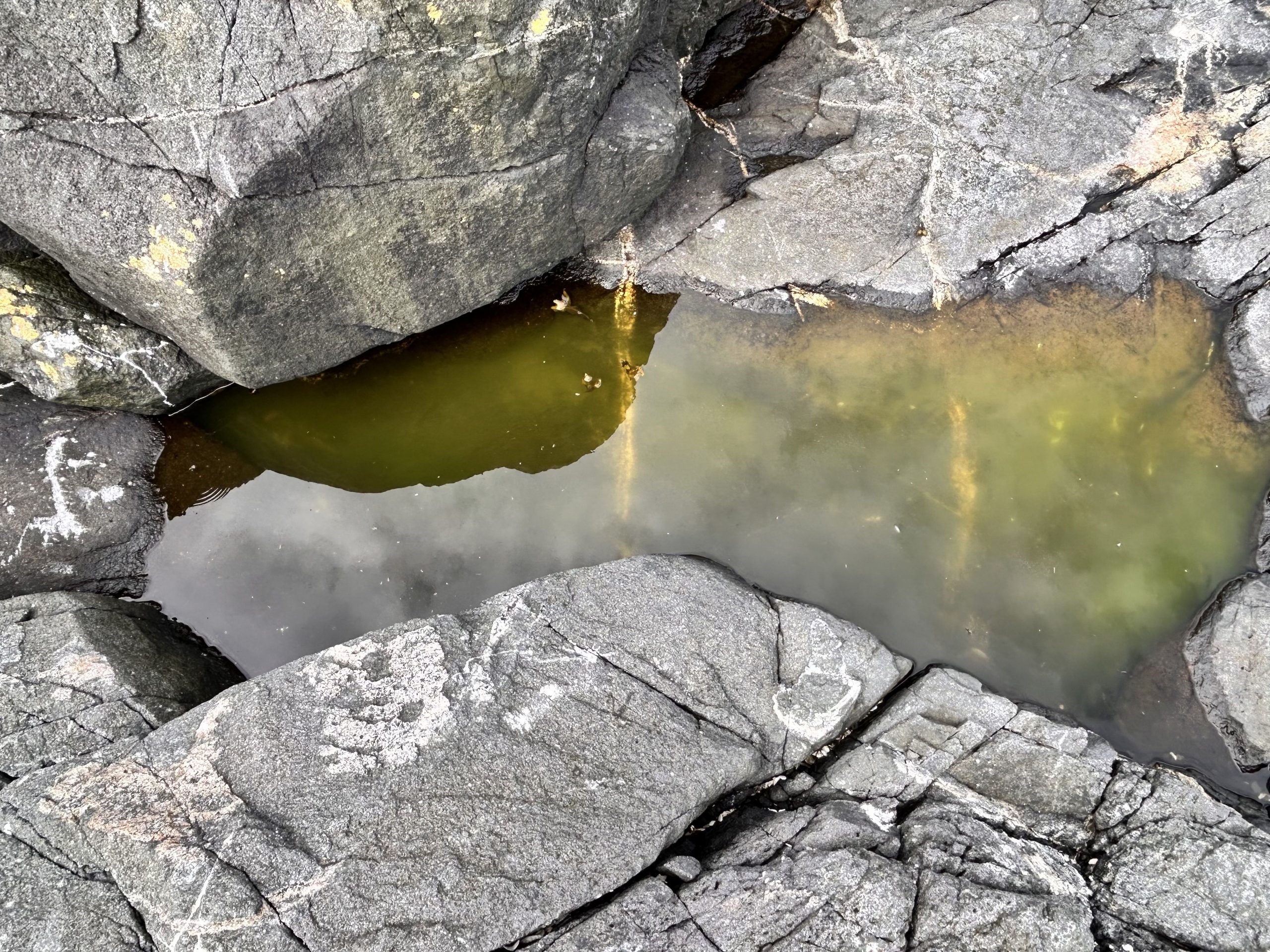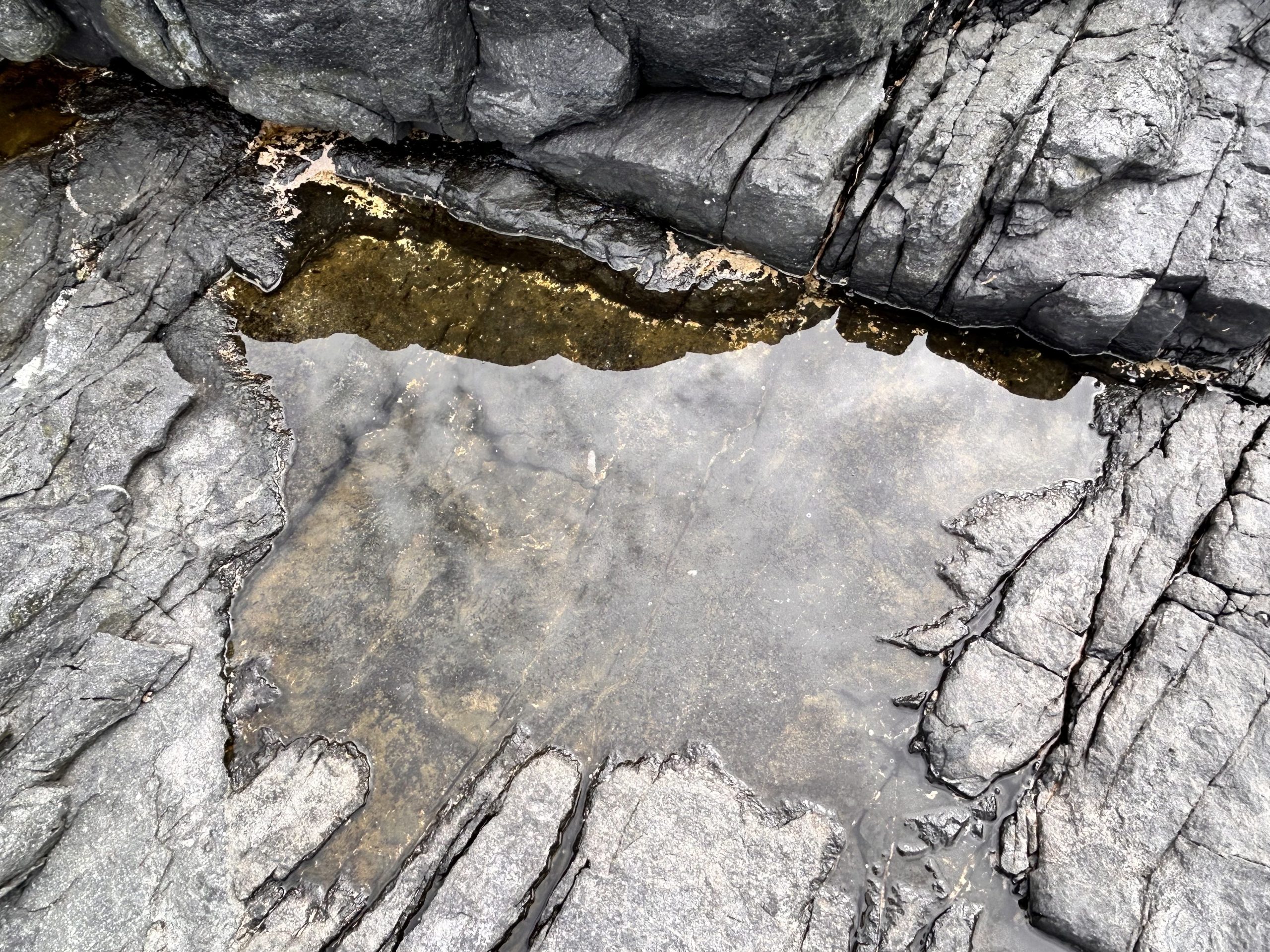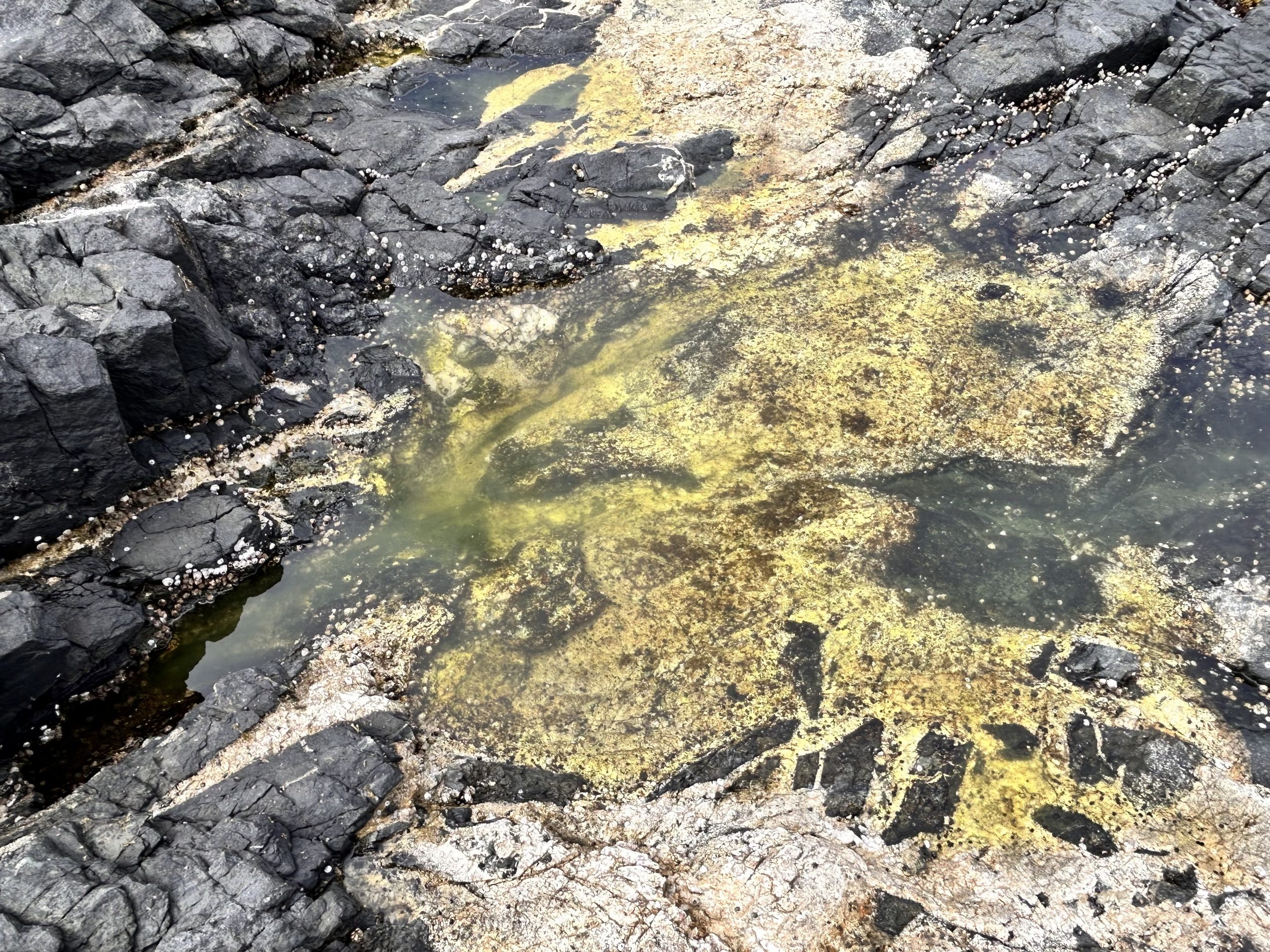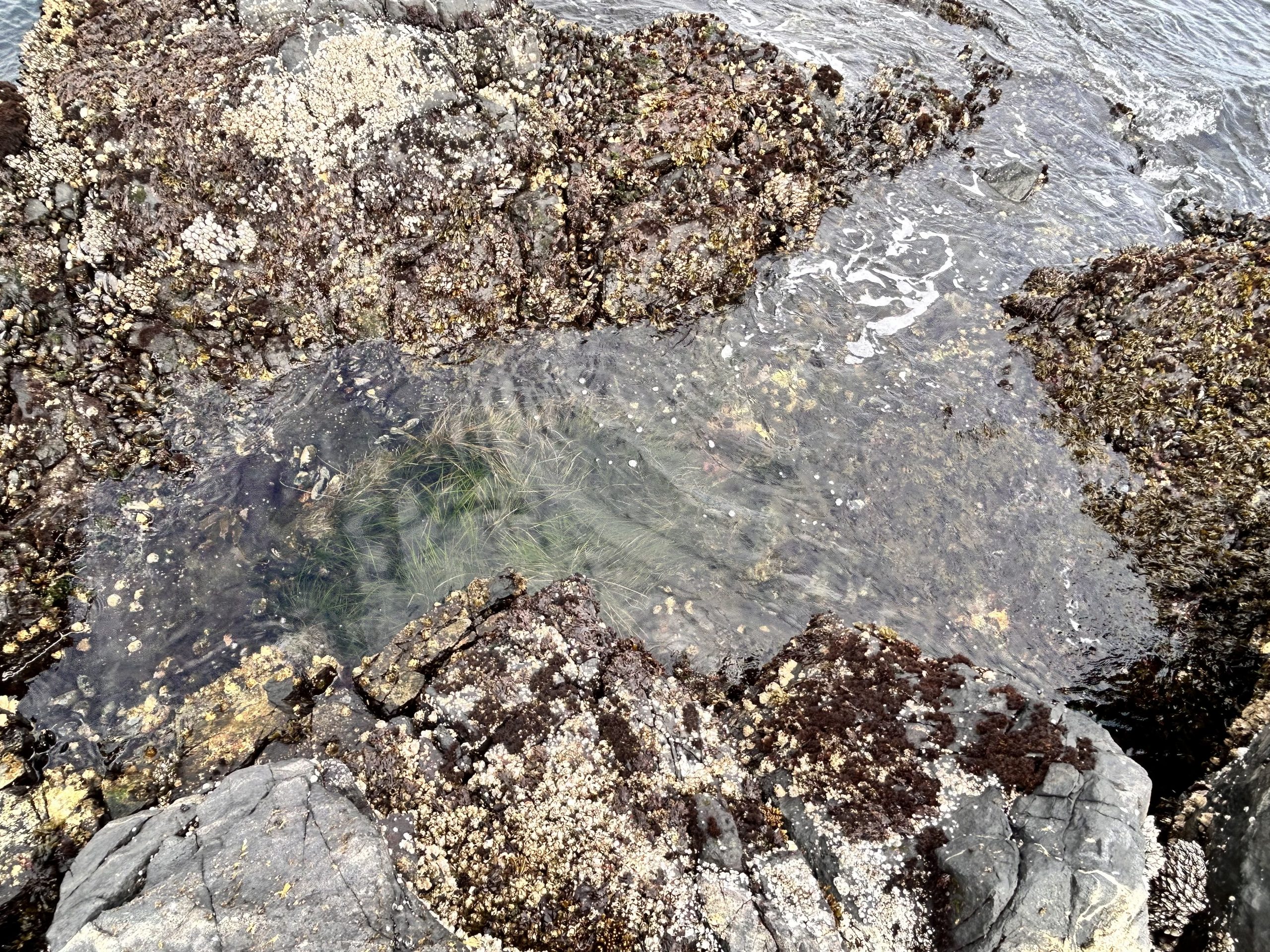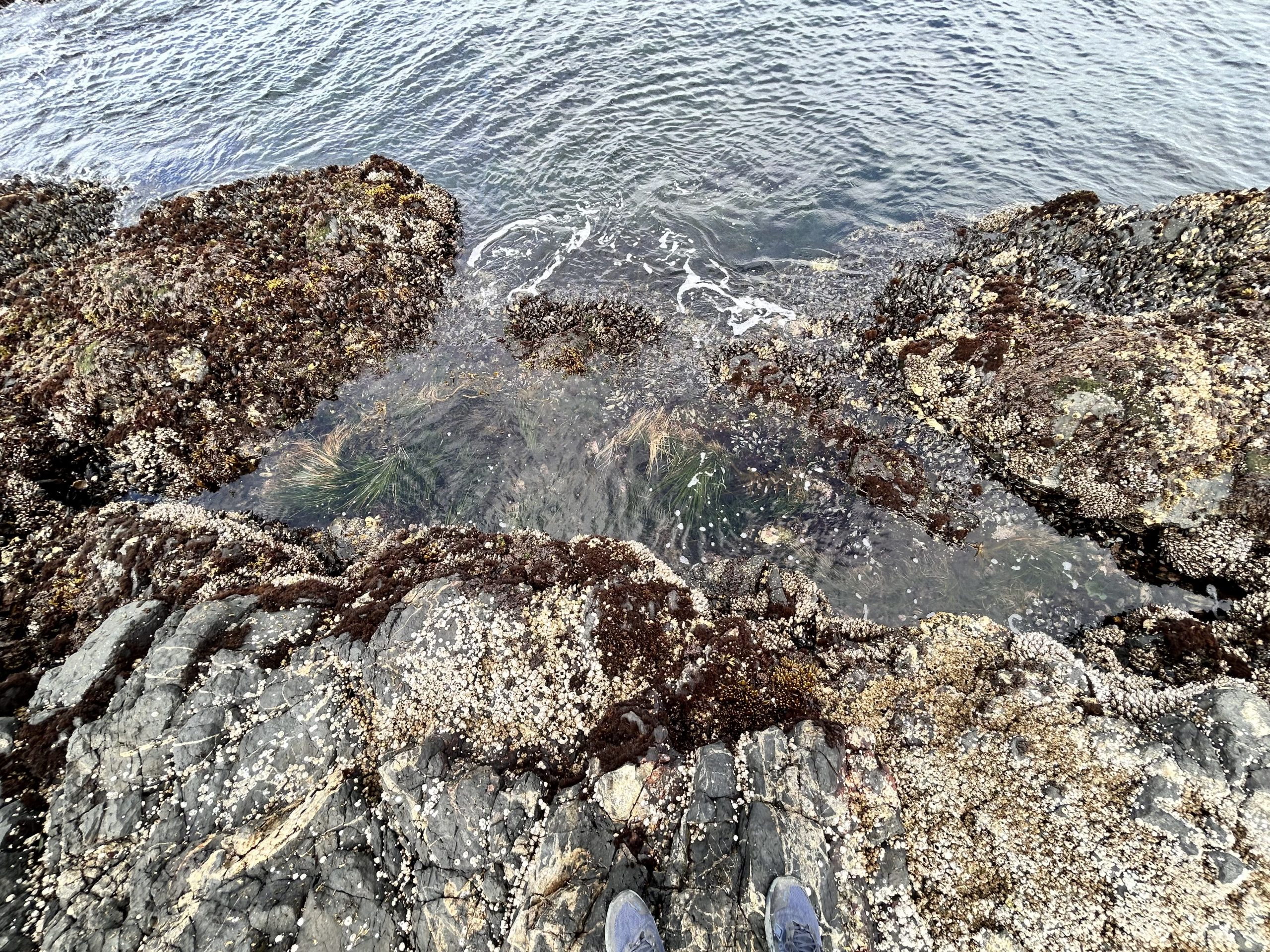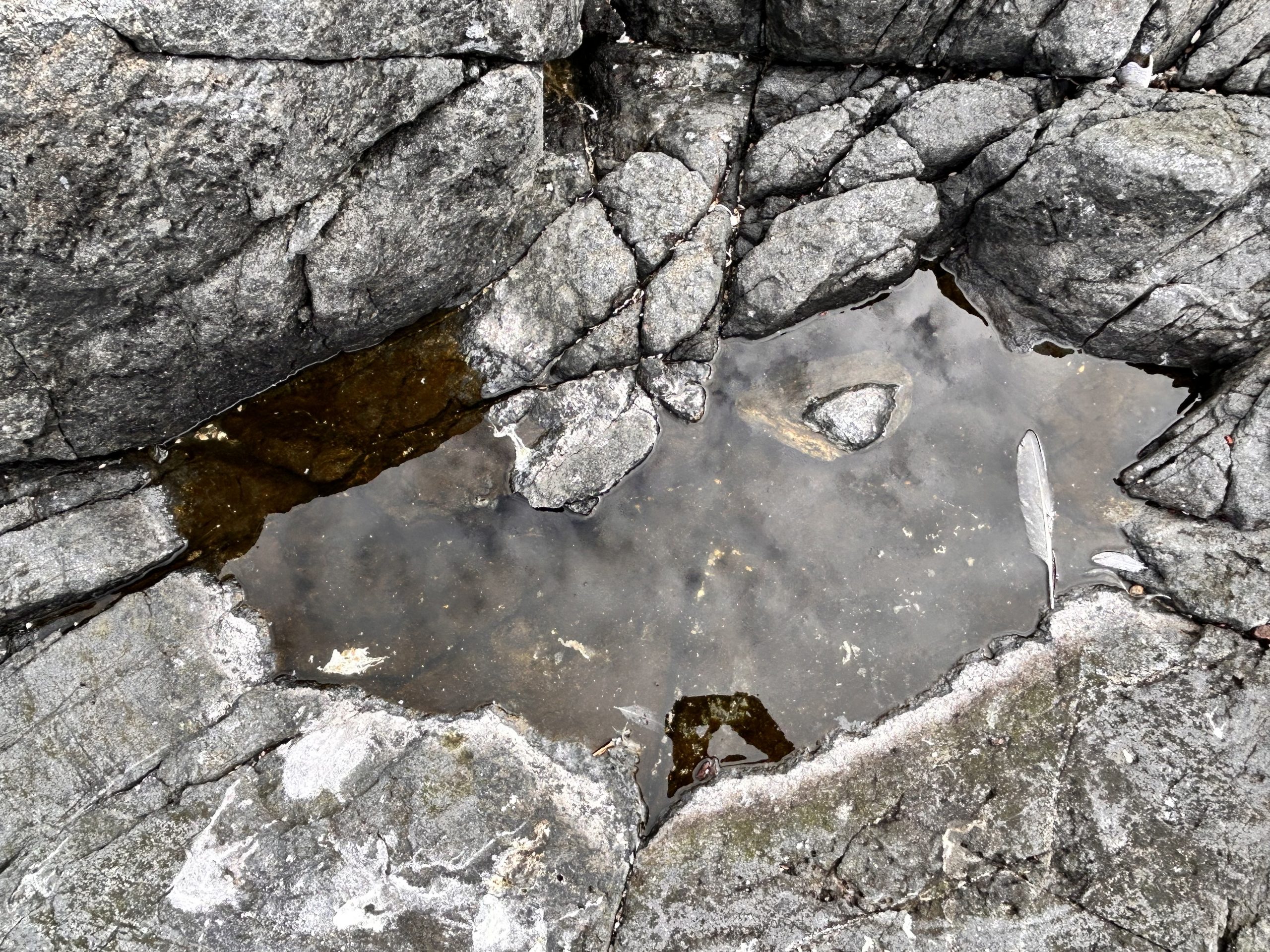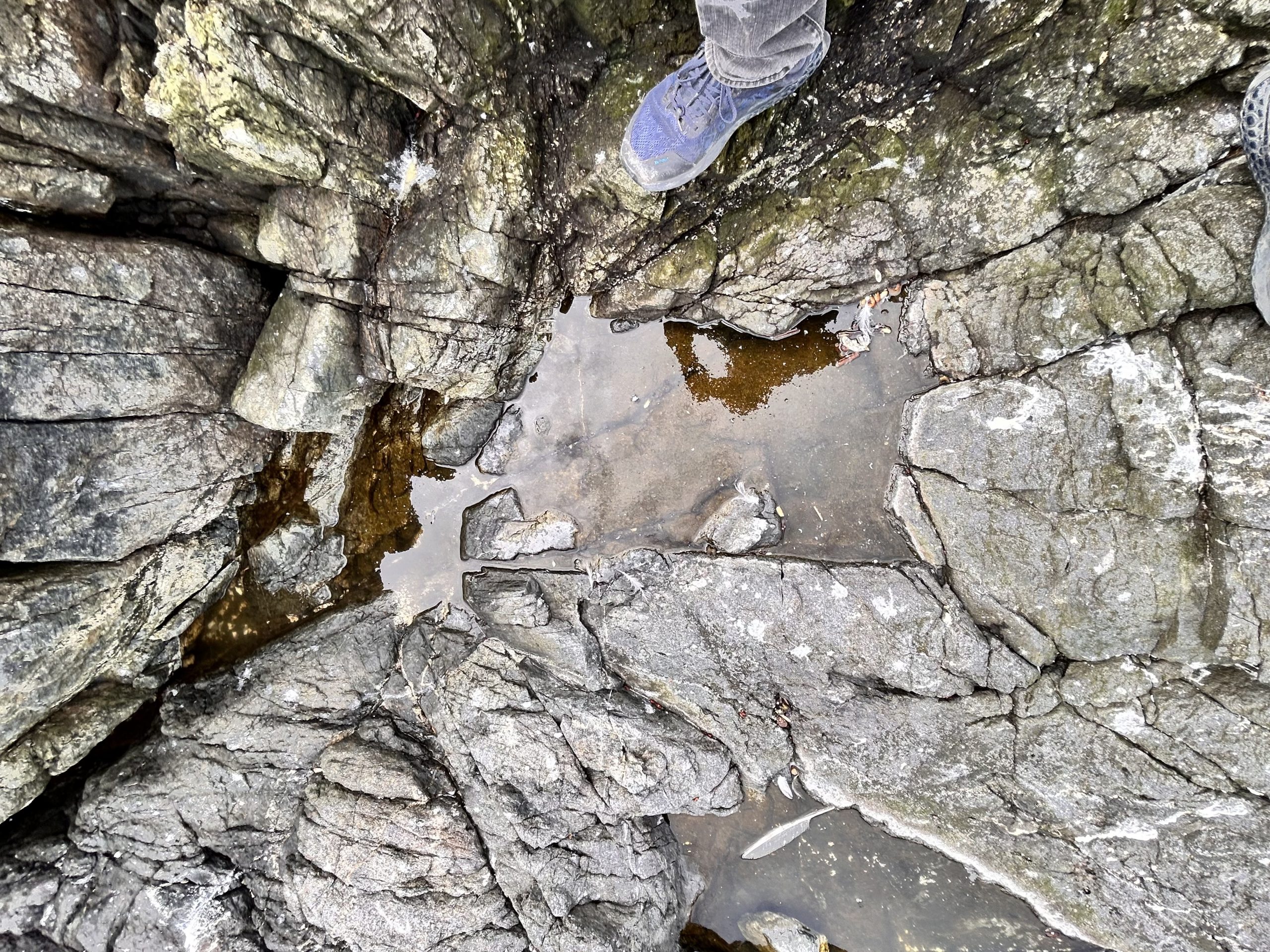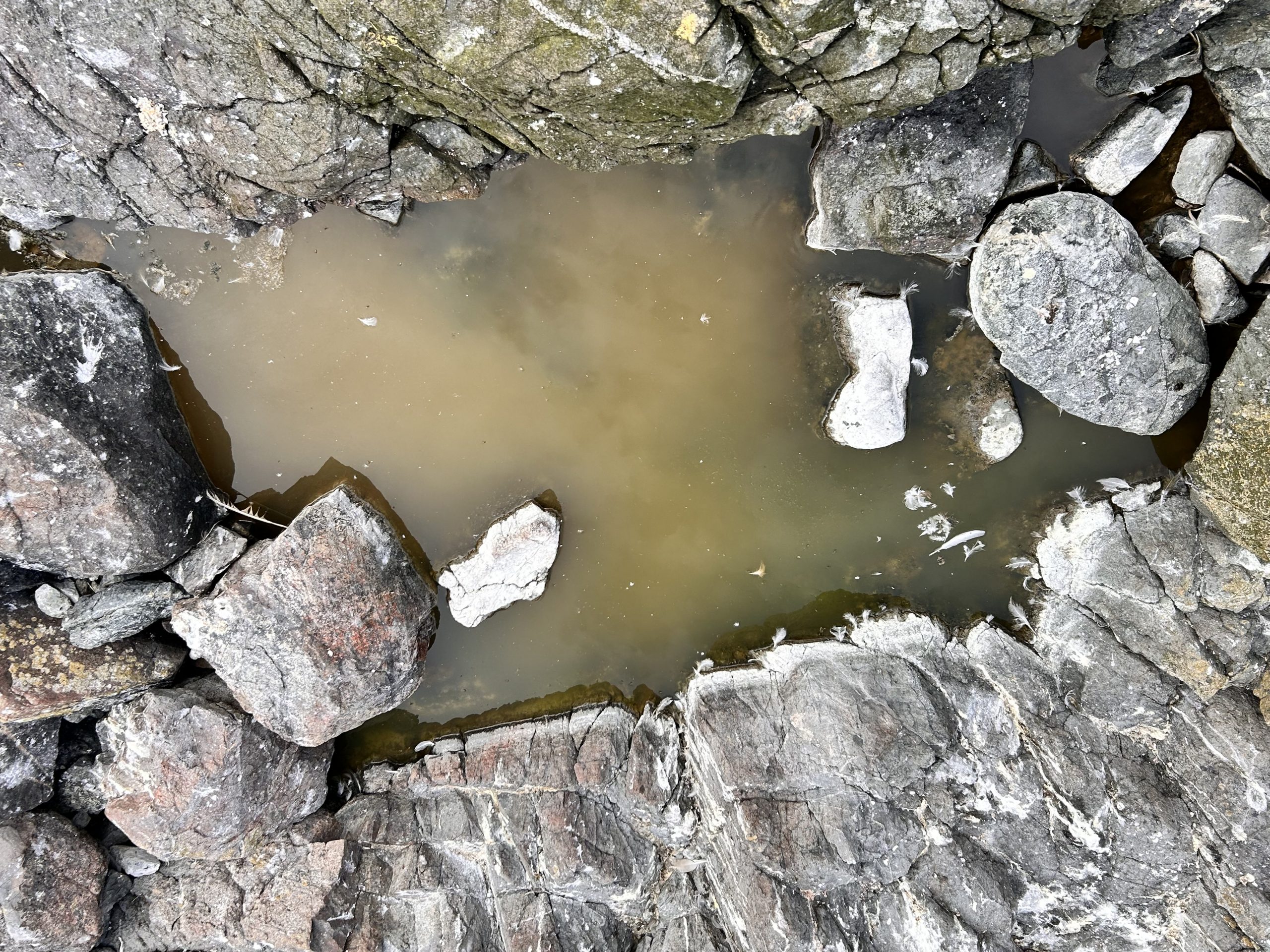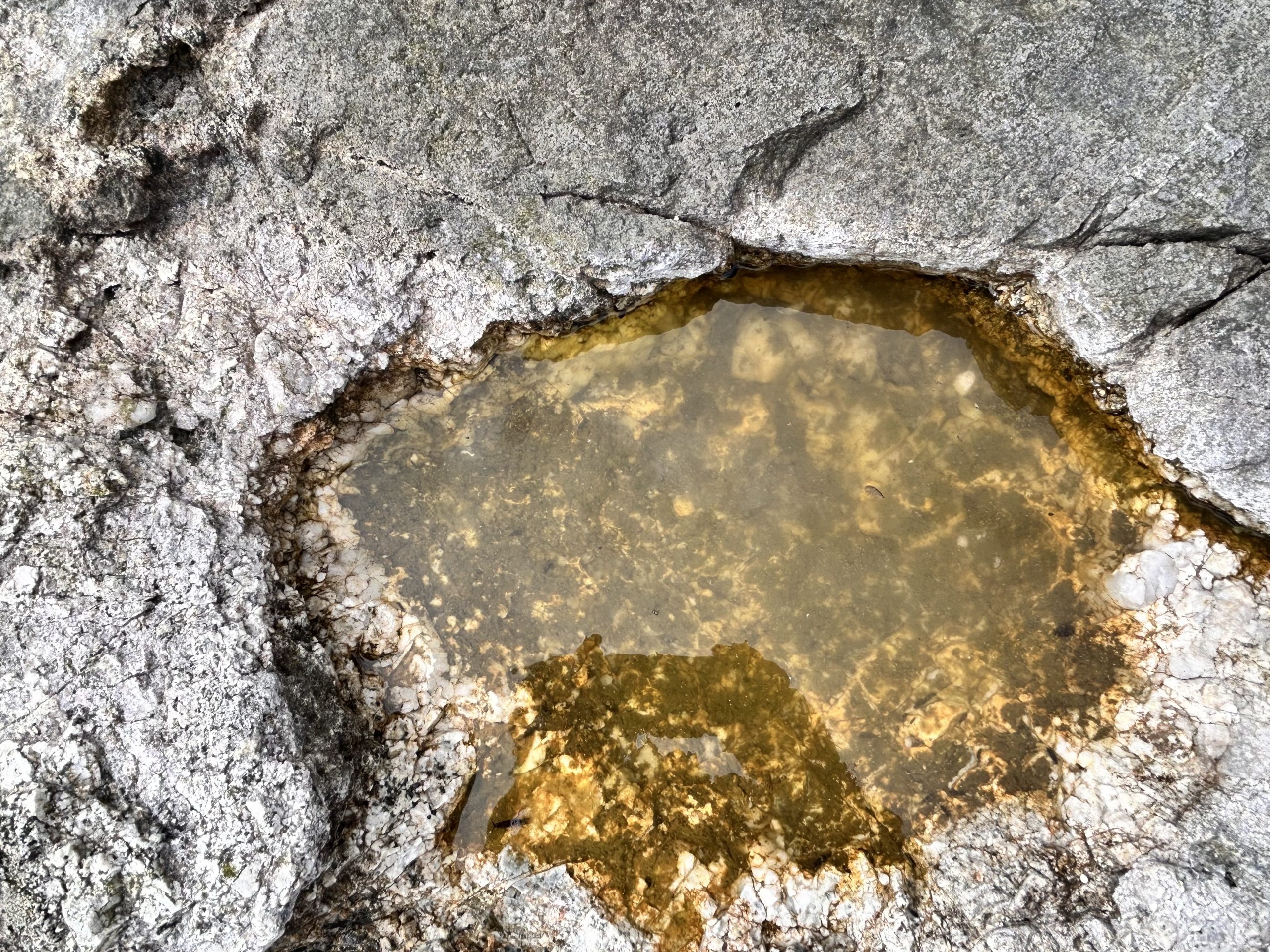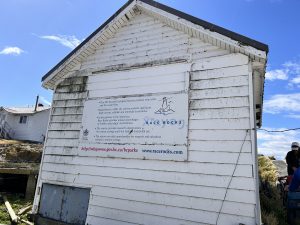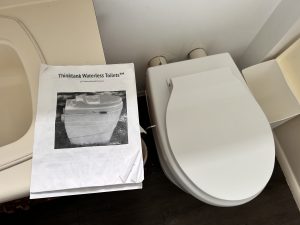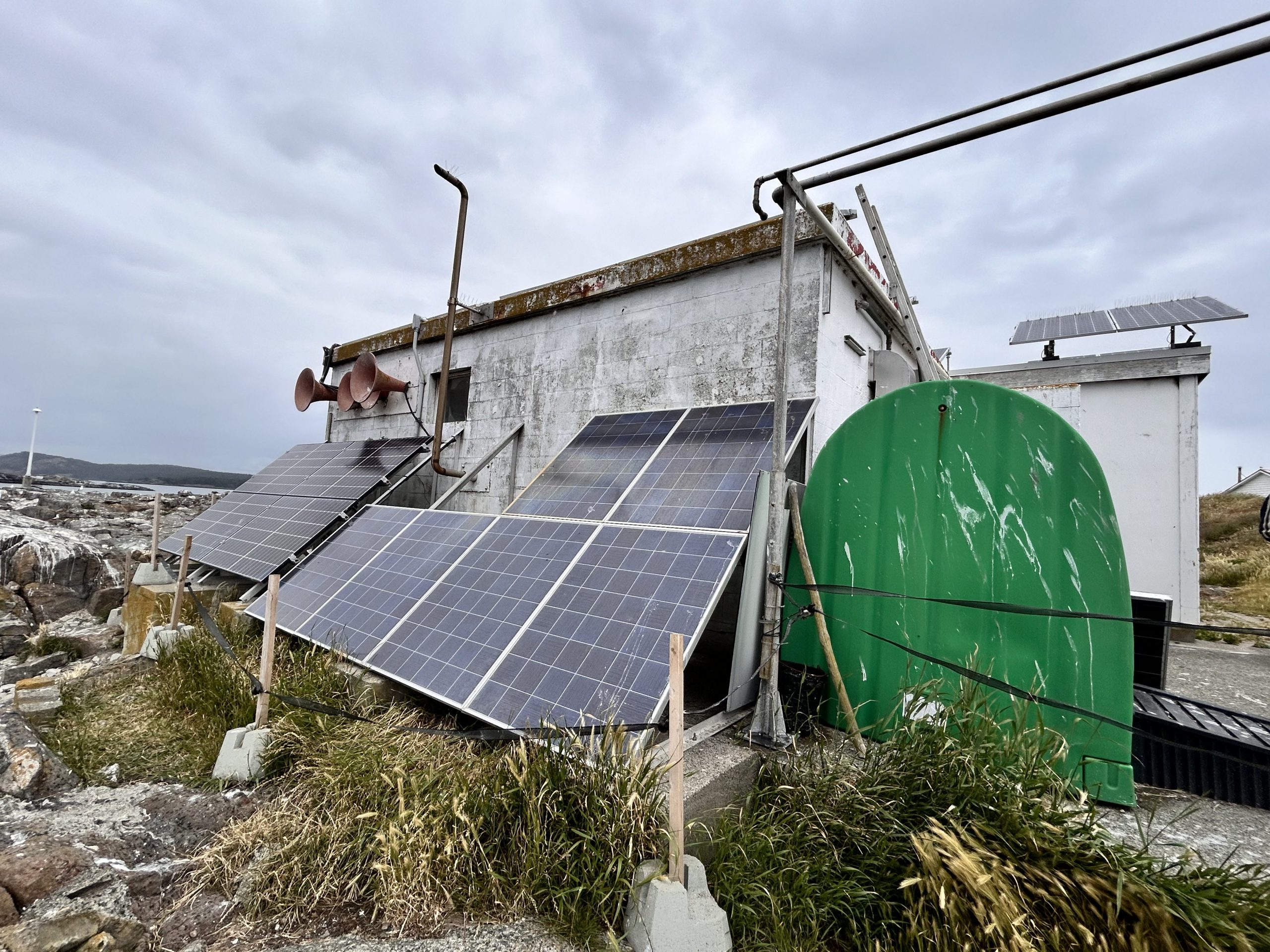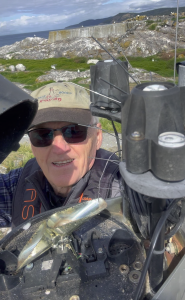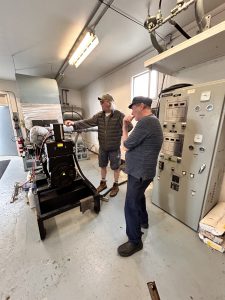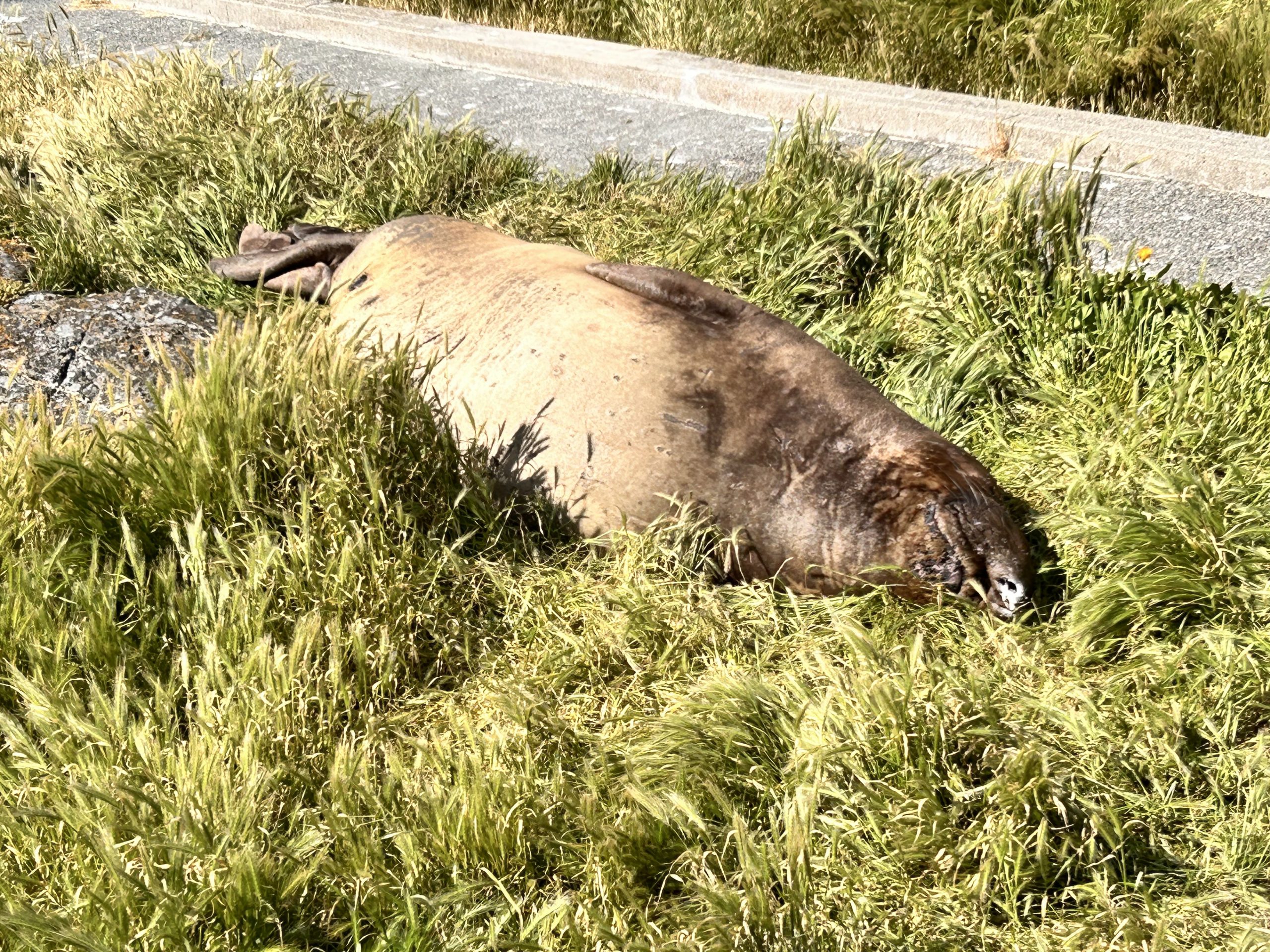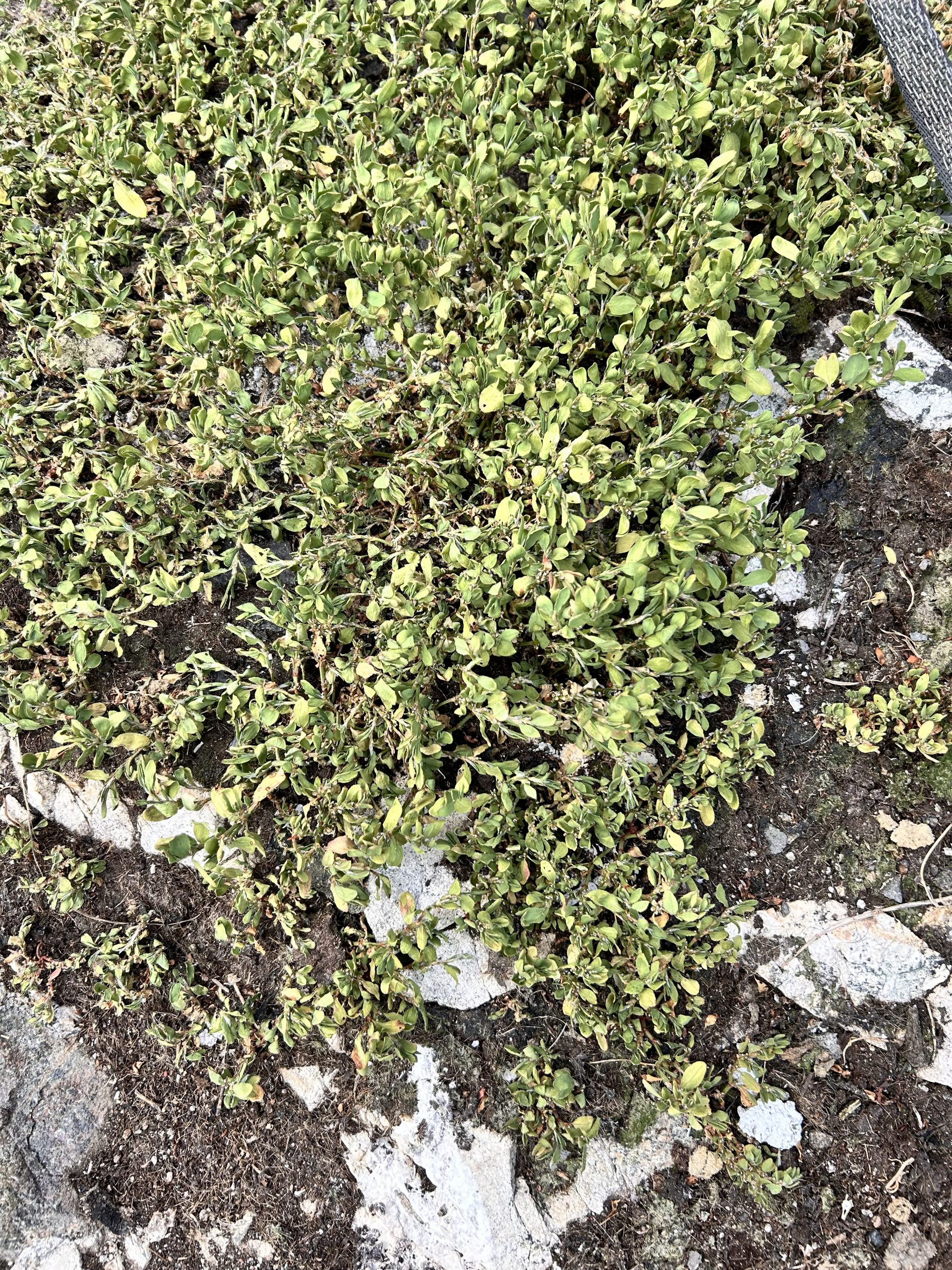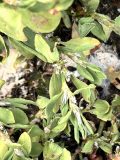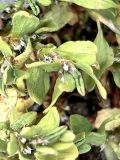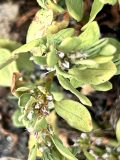Author Archives: Garry Fletcher
Race Rocks ER #97 Warden’s Report May 2025
Ecological Reserve warden Garry Fletcher went out to Race Rocks in May 2025 with Laurag Verhegge and Isabelle Groc on the new Pearson College Boat with College staff Richard Taggart and Mike White and electrician Jordan Cole, who was going out to test and repair corroded attachments on some of the solar panels.
At the mouth of Pedder Bay near the small island on the north side we came across a sea otter foraging for crabs. This was a great opportunity for Isabelle to get some good photos for her project she is doing on Sea Otters.
 On our arrival at the Ecological Reserve, we were greeted at the jetty by the Ecoguardian hired by Lester Pearson College, Christine Chourmouzis. Christine will be there through the next few weeks in July. I might add that I have appreciated her excellent coverage of events at Race Rocks in this log for this website, and she has been an effective warden in looking after the operations on the island.
On our arrival at the Ecological Reserve, we were greeted at the jetty by the Ecoguardian hired by Lester Pearson College, Christine Chourmouzis. Christine will be there through the next few weeks in July. I might add that I have appreciated her excellent coverage of events at Race Rocks in this log for this website, and she has been an effective warden in looking after the operations on the island.
One female elephant summer has stayed on the island for the summer, normally they have all left by now and return later in the year. She is moulting now. One photogenic California Sea lion also greeted us on arrival.
Christine has also discovered several new plant species on the island. She showed these to me and I have posted them on iNaturalist where they can be seen. Eventually they will get their own page in the Biodiversity section here.
I was not able to find any Romanzoffia or mist maidens in one of their usual spots but the long ago introduced Turkish gladiolus has spread to a few new locations East of the Ecoguardians residence.
The Glaucous winged gulls were in full nesting mode and one aggressive adult even knocked my hat off while I was on a sidewalk.
One nest contained eggs of different colours. I am am not sure if that is normal.
 Some records are not being recorded on the Davis weather instrument and after a full cleaning some sensors are still not recording so we are looking into that.
Some records are not being recorded on the Davis weather instrument and after a full cleaning some sensors are still not recording so we are looking into that.
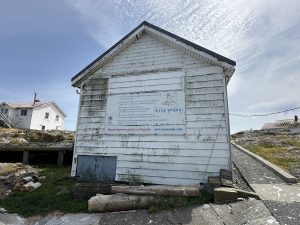 We will be asking BC Parks for a replacement of the ER sign. It has withstood the harsh environment for a good length of time now but is showing wear and missing one section.
We will be asking BC Parks for a replacement of the ER sign. It has withstood the harsh environment for a good length of time now but is showing wear and missing one section.
Christine did the seawater measurements while we were there. A probe is lowered of the end of the jetty to a meter depth every day at the time of the maximum flooding current. These records are submitted monthly to the Institute of Ocean Sciences at Pat Bay. This link provides the seawater records for past months .
https://racerocks,ca/tag/seawater-data/
One of the ecotourism boats passed by while we were there. In a past agreement made with the ecotourism companies and BC Parks, boats are required to stay in the center of the channel in order to comply with regulations for marine mammal viewing .
I noticed that the concrete and wood refuse left in piles from previous construction and repair work that was supposed to be taken off the island by a BC Parks vessel are still there after many reminders by Pearson College staff.
Past warden’s reports are at this link
https://racerocks.ca/category/er-warden-report/
BIRD LIST – Race Rocks Ecological Reserve
The following Bird List for Race Rocks Ecological Reserve was reorganized by Ernie Chang of Metchosin, BC. in November 2024 in order to have the correct AOU NACC order and to add observations recorded in iNaturalist. The Race Rocks species list and image gallery with all species recorded in the Ecological Reserve is the source of the Race Rocks List.
| Race Rocks List (in AOU NACC order) | iNaturalist list (link to gallery) |
| Order Anseriformes: geese and ducks: | |
| Chen caerulescens (Lesser Snow goose) | |
| Anser albifrons (Greater white-fronted Goose) | Anser albifrons – 1 (Greater White-Fronted Goose) |
| Branta bernicla (Black Brant Goose): | Branta bernicla – 1 (Black Brant) |
| Branta hutchinsii (Cackling Goose): | Branta hutchinsii – 1 (Cackling Goose) |
| Branta canadensi (Canada Goose): | Branta Canadensis – 18 (Canada Goose) |
| Anas platyrhynchos (Mallard): | Anas platyrhynchos – 1 (Mallard) |
| Anas carolinensis (Green-winged Teal): | Anas crecca carolinensis – 1 (American Green-winged Teal) |
| Histrionicus histrionicus (Harlequin duck) | Histrionicus histrionicus – 8 (Harlequin Duck) |
| Melanitta perspicillata ( surf scoter) | Melanitta perspicillata – 1 (Surf Scoter) |
| Bucephala albeola (Bufflehead) | Bucephala albeola – 1 (Bufflehead) |
| Mergus merganser (Common merganser) | Mergus merganser – 1 (Common Merganser) |
| Order Podicipediformes: grebes: | |
| Aechmophorus occidentalis (Western Grebe): | Aechmophorus occidentalis – 1 (Western Grebe) |
| Order Columbiformes: doves: | |
| Columba livia (Rock Dove): | Columba livia domestica (Feral Pigeon) |
| Order Charadriiformes: other shore&seabirds | |
| Haematopus bachmani (Black oystercatcher): | Haematopus bachmani – 19 (Black Oystercatcher) |
| Pluvialis squatarola (Black-bellied Plover): | Pluvialis squatarola – 1 (Black-bellied Plover) |
| Pluvialis dominica (American Golden Plover): | Pluvialis dominica – 1 (American Golden-Plover) |
| Charadrius vociferus (Kildeer): | Charadrius vociferus – 1 (Killdeer) |
| Numenius phaeopus (Whimbrel): | Numenius phaeopus – 1 (Whimbrel) |
| Limosa fedoa (Marbled godwit) | Limosa fedoa – 1 (Marbled Godwit) |
| Arenaria interpret (Ruddy turnstone): | Arenaria interpres – 1 (Ruddy Turnstone) |
| Arenaria melanocephala (Black turnstone): | Arenaria melanocephala – 19 (Black Turnstone) |
| Calidris canutus (Red Knot): | Calidris canutus – 1 (Red Knot) |
| Aphriza virgata (Surfbird): | Calidris virgata – 5 (Surfbird) |
| Calidris alba (Sanderling): | Calidris alba – 2 (Sanderling) |
| Calidris alpina (Dunlin) | Calidris alpina – 4 (Dunlin) |
| Calidris ptilocnemis (Rock sandpiper): | Calidris ptilocnemis – 1 (Rock Sandpiper) |
| Calidris minutillam (Least sandpiper): | Calidris minutilla – 1 (Least Sandpiper) |
| Calidris mauri (Western sandpiper): | Calidris mauri – 2 (Western Sandpiper) |
| Limnodromus griseus (Short-billed Dowitcher): | Limnodromus griseus – 2 (Short-billed Dowitcher) |
| Actitis macularius (Spotted Sandpiper): | Actitis macularius – 1 (Spotted Sandpiper) |
| Tringa incana (Wandering Tattler): | Tringa incana – 1 (Chevalier errant) |
| Tringa melanoleuca (Greater Yellowlegs): | Tringa melanoleuca – 1 (Greater Yellowlegs) |
| Phalaropus lobatus (Red-necked Phalarope): | Phalaropus lobatus – 4 (Red-necked Phalarope) |
| Phalaropus fulicarius ( Red Phalarope): | Phalaropus fulicarius – 1 (Red Phalarope) |
| Order Charadriiformes: Stercorarius Jaegers | |
| Stercorarius pomarinus – 1 (Pomarine Jaeger) | |
| Order Charadriiformes: Alcidae | |
| Uria aalge (Common Murre): | Uria aalge – 9 (Common Murre) |
| Cepphus columba (Pigeon Guillemot): | Cepphus columba – 36 (Pigeon Guillemot) |
| Brachyramphus marmoratus (Marbled Murrelet ): | Brachyramphus marmoratus – 1 (Marbled Murrelet) |
| Synthliboramphus antiquus (Ancient Murrelet): | Synthliboramphus antiquus – 1 (Ancient Murrelet) |
| Cerorhinca monocerata (Rhinocerous Auklet): | Cerorhinca monocerata – 3 (Rhinoceros Auklet) |
| Order Charadriiformes: Larinae: gulls: | |
| Xema sabini – 1 (Sabine’s Gull) | |
| Larus philadelphia (Bonapartes gull): | Chroicocephalus philadelphia – 1 (Bonaparte’s Gull) |
| Larus heermanni (Heermann’s Gull): | Larus heermanni – 14 (Heermann’s Gull) |
| Larus canis (Mew gull): | Larus brachyrhynchus – 1 (Short-billed Gull) |
| Larus occidentalis (Western gull): | Larus occidentalis – 2 (Western Gull) |
| Larus californicus (Califiornia Gull): | Larus californicus – 6 (California Gull) |
| Larus argentatus – 1(EuropeanHerring Gull) | |
| Larus glaucescens (Glaucous-winged gull): | Larus glaucescens – 13 (Glaucous-winged Gull) |
| Larus hyperbolus (Glaucous gull): | Larus hyperboreus – 1 (Glaucous Gull) |
| Larus thayeri (Thayer’s gull): | Larus glaucoides thayeri – 3 (Thayer’s Gull) |
| Rissa tridactyla (Black-legged Kittiwake): | Rissa tridactyla – 1 (Black-legged Kittiwake) |
| Larus galucesens x occidentalis -1 (Olympic Gull) | |
| Order Charadriiformes: terns | |
| Hydroprogne caspia(Caspian Tern): | Hydroprogne caspia – 1 (Caspian Tern) |
| Sterna paradisaea – 1 (Arctic Tern) | |
| Order Gaviformes: Loons | |
| Gavia pacifica (Pacific Loon) | Gavia pacifica – 2 (Pacific Loon) |
| Order Procellariiformes: albatrosses,shearwaters: | |
| Phoebastria mutabilis (Laysan Albatross): | |
| Ardenna tenuirostris (Short-tailed Shearwater) | Ardenna tenuirostris – 2 (Short-tailed Shearwater) |
| Order Suliformes: Phalacrocoracidae cormorants | |
| Phalacrocorax penicilatu (Brandt’s Cormorant): | Urile penicillatus – 18 (Brandt’s Cormorant) |
| Phalacrocorax pelagicus (Pelagic Cormorant): | Urile pelagicus – 9 (Pelagic Cormorant) |
| Phalacrocorax auritas (Double Crested Cormorant): | Nannopterum auritum – 5 (Double-crested Cormorant) |
| Order Pelecaniformes: Pelicans and Herons | |
| Pelecanus occidentalis (Brown pelican): | Pelecanus occidentalis – 5 (Brown Pelican) |
| Ardea herodia (Great Blue Heron): | Ardea herodias – 1 (Great Blue Heron) |
| Order Cathartiformes: Vultures | |
| Cathartes aura (Turkey Vulture): | |
| Order Acciptriformes: hawks and eagles: | |
| Pandion haliaetus (Osprey): | Pandion haliaetus – 1 (Osprey) |
| Haliacetus leucocepfalus (Bald eagle): | Haliaeetus leucocephalus – 34 (Bald Eagle) |
| Buteo jamaicensis (Red-tailed Hawk): | Buteo jamaicensis calurus – 1 (Western Red-tailed Hawk) |
| Order Strigiformes: owls: | |
| Bubo virginianus (Great Horned Owl): | Bubo virginianus – 1 (Great Horned Owl) |
| Bubo scandiacus (Snowy Owl): | Bubo scandiacus – 1 (Snowy Owl) |
| Strix varia (Barred Owl): | Strix varia – 1 (Barred Owl) |
| Aegolius funereus (Boreal Owl): | Aegolius funereus – 1 (Boreal Owl) |
| Order: Coraciiformes | |
| Megaceryle alcyon ( Belted Kingfisher): | |
| Order Falconiformes: falcons: | |
| Falco peregrinus (Peregrine falcon): | |
| Order Passeriformes: corvidae | |
| Corvus caurinus (North Western Crow): | Corvus brachyrhynchos caurinus – 1 (Northwestern Crow) |
| Corvus corax (Common Raven): | Corvus corax – 1 (Common Raven) |
| Order Passeriformes: Alaudidae | |
| Eremophila alpestris (Horned lark): | Eremophila alpestris – 1 (Horned Lark) |
| Order Passeriformes: Hirundinidae | |
| Progne subis (Purple martin): | |
| Hirundo rustica (Barn Swallow): | Hirundo rustica – 1 (Barn Swallow) |
| Order Passeriformes: Regulidae | |
| Regulus satrapa (Golden-crowned kinglet): | Regulus satrapa – 1 (Golden-crowned Kinglet) |
| Order Passeriformes: Troglodytidae | |
| Troglodytes pacificus (Pacific wren): | Troglodytes pacificus – 2 (Pacific Wren) |
| Order Passeriformes: Sturnidae | |
| Sturnus vulgaris (European Starling): | |
| Order Passeriformes: Turdidae | |
| Turdus migratorius (American Robin): | Turdus migratorius – 1 (American Robin) |
| Order Passeriformes: Motacilladea | |
| Anthus rubescens (American Pipit): | Anthus rubescens – 1 (American Pipit) |
| Order Passeriformes: Fringillidae | |
| Spinus tritis (American Goldfinch) | Spinus tristis – 1 (American Goldfinch) |
| Order Passeriformes: Calcaridae | |
| Calcarius lapponicus (Lapland Longspur): | Calcarius lapponicus – 1 (Lapland Longspur) |
| Plectrophenax nivalis (Snow Bunting): | Plectrophenax nivalis – 1 (Snow Bunting) |
| Order Passeriformes: Passerellidae sparrows | |
| Junco hyemalis (Oregon Junco): | Junco hyemalis – 1 (Dark-eyed Junco) |
| Passerella iliaca (Fox Sparrow): | Passerella iliaca – 1 (Fox Sparrow) |
| Zonotricha atricapilla (Golden-crowned sparrow): | Zonotrichia atricapilla – 1 (Golden-crowned Sparrow) |
| Passerculus sandwichensis (Savannah sparrow): | Passerculus sandwichensis – 1 (Savannah Sparrow) |
| Passer domesticus (House Sparrow): | Passer domesticus – 1 (House Sparrow) |
| Melospiza melodia (Song Sparrow): | |
| Order Passeriformes: Icteridae | |
| Xanthocephalus xanthocephalus (Yellow-headed blackbird) | Xanthocephalus xanthocephalus – 1 (Yellow-headed Blackbird) |
| Agelaius phoeniceus (Red-winged blackbird) | Agelaius phoeniceus – 1 (Red-winged Blackbird) |
| Molothrus ater (Brown-headed cowbird): | |
| Order Passeriformes: Parulidae | |
| Dendroica coronata (Audubon’s yellow-rumped warbler): | Setophaga coronata – 1 (Yellow-rumped Warbler) |
| Setophaga townsendi (Townsend’s warbler) | Setophaga townsendi – 1 (Townsend’s Warbler) |
| Now if anyone wants to volunteer to do the same with the other Chordates, the invertebrates, algae and fungi on the Race Rocks Taxonomy , examine iNaturalist records for other Ecological Reserves, Ernie Chang has produced this handbook: https://ecoreserves.bc.ca/2024/11/29/using-ecoreserves-of-bc-umbrella-for-birds/ |
Animal Census November 25 2024
| RR Ecoreserve ANIMAL CENSUS . recorded by Derek Sterling |
||||
| 2024-11-25 | 2024-12-18 | 2024-12-25 | ||
| Elephant Seal(male) | ||||
| Elephant seal (female) | 1 | |||
| Steller’s Sea Lion | 289 | |||
| California Sea Lion | 263 | |||
| Harbour Seal | 23 | |||
| Sea Otter | ||||
| Orca | ||||
| Humpback | 3 | |||
| Gray Whale | ||||
| Species 1 | ||||
| Species 2 | ||||
| Species 3 | ||||
| Canada Geese | 27 | |||
| Harlequin Duck | 4 | |||
| Black Oystercatcher | 12 | |||
| Black Turnstone | 28 | |||
| Surfbird | ||||
| Whimbrel | ||||
| Killdeer | 3 | |||
| Dunlin | ||||
| Black-bellied Plover | ||||
| Ruddy Turnstone | ||||
| Species 1 | ||||
| Species 2 | ||||
| Species 3 | ||||
| Species 4 | ||||
| Pigeon Guillemot | ||||
| Common Murre | ||||
| Rhinoceros Auklet | ||||
| Species 1 | ||||
| Species 2 | ||||
| Species 3 | ||||
| Species 4 | ||||
| Glaucous Winged Gull | ||||
| Western Gull | ||||
| Glaucous X Western Gull Hybrid | ||||
| Iceland(Thayer’s) Gull | ||||
| Heerman’s Gull | ||||
| California Gull | ||||
| Short-billed Gull | ||||
| Gull Species unknown | 226 | |||
| Gull Species 2 | ||||
| Gull Species 3 | ||||
| Cormorant total | ||||
| Brandt’s Cormorant | ||||
| Double-Crested Cormorant | ||||
| Cormorant species unknown | 283 | |||
| Pelagic Cormorant | ||||
| Pelican | ||||
| Great Blue Heron | ||||
| Bald Eagle Juvenile | 4 | |||
| Bald Eagle Adult | 6 | |||
| Peregrine Falcon | ||||
| Raptor Species 1 | ||||
| Raptor Species 2 | ||||
| Raptor Species 3 | ||||
| Western Crow | ||||
| Raven | ||||
| Purple Martin | ||||
| Barn Swallow | ||||
| Pacific Wren | ||||
| Savannah Sparrow | ||||
| Fox Sparrow | ||||
| Species 1 | ||||
| Species 2 | ||||
| Species 3 | ||||
| Species 4 | ||||
| Other Species 1 | ||||
| Other Species 2 | ||||
| Other Species 3 | ||||
in addition to the “Regular” birds i saw large flocks (up to about 70 birds each) of Black Oyster Catchers and Black turnstones.
- Animal Tracking and Injuries:
- 1 California Sea Lion identified as “Tuck” disentangled last year at Race Rocks…. still has a large open wound on the back of his neck, but it is quite well healed compared to the original injury
Entangled Sea lion Rescued at Race Rocks Ecological Reserve
The following article from the Victoria Times Colonist with a video of an interview with Dr. Martin Haulena of the Vancouver Aquarium appeared in the Times Colonist on October 29 2024, concerning the rescue of an entangled sea lion at Race Rocks Ecological Reserve:
T.C. Article on Entangled Sealion Release
The following article from the Victoria Times Colonist with a video of an interview with Dr. Martin Haulena of the Vancouver Aquarium appeared in the Times Colonist on October 29 2024 concerning the rescue of an entangled sea lion at Race Rocks Ecological Reserve:
Carduus acanthoides : Plumeless thistle- The Race Rocks taxonomy
from https://racerocks.ca/upkeep-day/
Neha Acharya-Patel the ecoguardian at Race Rocks identified this new species for Race Rocks in the log today. 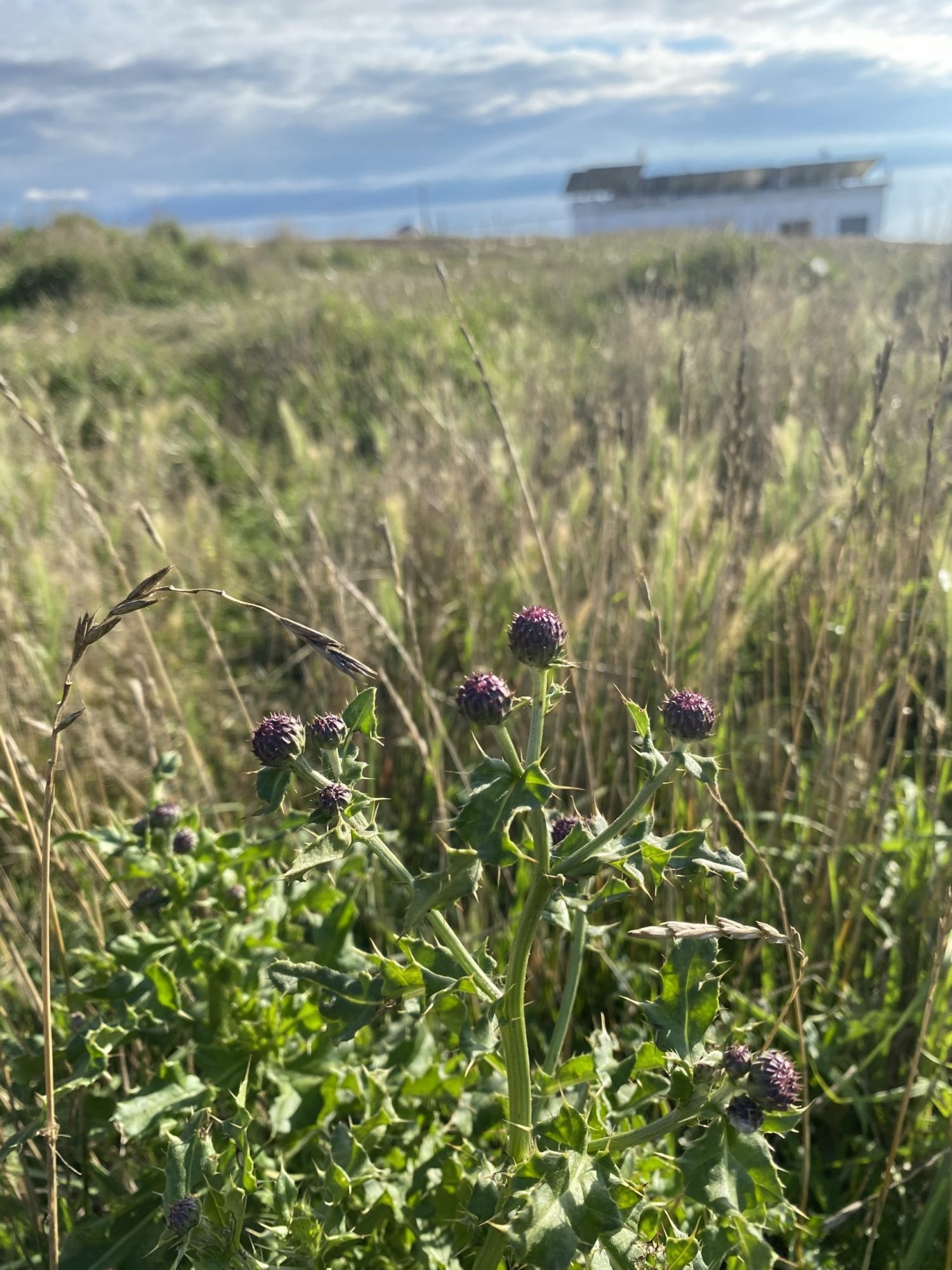
From Wikipedia, the classification as follows
| Scientific classification |
|
|---|---|
| Kingdom: | Plantae |
| Clade: | Tracheophytes |
| Clade: | Angiosperms |
| Clade: | Eudicots |
| Clade: | Asterids |
| Order: | Asterales |
| Family: | Asteraceae |
| Genus: | Carduus |
| Species: |
C. acanthoides
|
| Binomial name | |
| Carduus acanthoides | |
Other Angiosperms at Race Rocks.
and Image File |
 The Race Rocks taxonomy is a collaborative venture originally started with the Biology and Environmental Systems students of Lester Pearson College UWC. It now also has contributions added by Faculty, Staff, Volunteers and Observers on the remote control webcams. The Race Rocks taxonomy is a collaborative venture originally started with the Biology and Environmental Systems students of Lester Pearson College UWC. It now also has contributions added by Faculty, Staff, Volunteers and Observers on the remote control webcams. |
Progne subus: Purple martin – The Race Rocks Taxonomy
On June 20, 2045 , Race Rocks Ecoguardian Christine Chourmouzis found a purple martin in her house
she writes in her log: Two purple martins were spotted on top of the tower and on roof of the Keepers’s house around noon. At 3 pm I discovered a purple martin had made its way down the chimney pipe into the wood stove. I am so glad the ashes were cold and I was able to get it back outside!
-
Purple martins suffered a severe population crash in the 20th century widely linked to the release and spread of European starlings in North America. European starlings and house sparrows compete with martins for nest cavities. Where purple martins once gathered in the thousands, by the 1980s they had all but disappeared. (Wikipedia)
They have excellent aerodynamic maneuvering control as they fly quickly over open areas catching insects with a wide opening mouth. They are valued for their voracious appetite for mosquitoes and flies. With their food being flying insects, the island certainly provides an abundant supply of the kelp fly Coelopa vanduzeei
Domain: Eukarya
Kingdom: Animalia
Phylum: Chordata
Sub-phylum: Vertebrata
Class: Aves
Order: Passeriformes
Family: Hirundinidae
Genus:Progne
Species: subis. (Linnaeus, 1758)
Common Name: Purple martin
Physical Description:
It is the largest swallow in North America.
With an average length of 20 cm (7.9 in) and a wingspan of up to 38 cm (15 in), the purple martin is the largest amongst the 90 odd species in the family Hirundinidae.[9]
Purple martins are sexually dimorphic. Adult males are entirely black with a glossy steel blue sheen, the only swallow in North America with such coloration. Adult females are dark on top with some steel blue sheen, and lighter underparts. Adults have a slightly forked tail.
Relationship with humans:
Continual maintenance and protection is required, as European starlings and house sparrows compete with martins as cavity-nesters, and will fight with martins over nest sites. Thus, unmonitored purple martin houses are often overtaken by more aggressive, non-native species.[3] Purple martin proponents are motivated by the concern that the purple martin would likely vanish from eastern North America were it not for this assistance.[24]( Wikipedia)
| Other Members of the Class Aves at Race Rocks |
and Image File |
 The Race Rocks taxonomy is a collaborative venture originally started with the Biology and Environmental Systems students of Lester Pearson College UWC. It now also has contributions added by Faculty, Staff, Volunteers and Observers on the remote control webcams. The Race Rocks taxonomy is a collaborative venture originally started with the Biology and Environmental Systems students of Lester Pearson College UWC. It now also has contributions added by Faculty, Staff, Volunteers and Observers on the remote control webcams.
June 20 2024 Christine Chourmouzis – Ecoguardian |
Race Rocks Ecological Reserve Warden’s Report June 14 2024
Garry Fletcher, ER Warden for Race Rocks visited the reserve on June 14, 2024
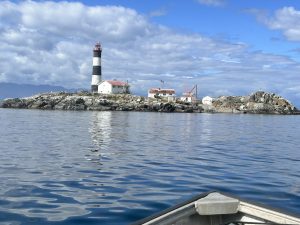 Greg Dickinson from Pearson College provided transport in Second Nature for the following group:
Greg Dickinson from Pearson College provided transport in Second Nature for the following group:
- Lisette and Mads – Mads is a former student and both are volunteering at Pearson College
- Garry Fletcher – Park Warden
- James Tuohy – future Ecoguardian
- Ann Nightingale and Andrew Jacobs – Rocky Point Bird Observatory
Upon docking I was struck by the number of Pigeon Guillemots on the rocks . Although I haven’t checked back in our records, there certainly seems to have been an increase in numbers
We were greeted by the new ecoguardian Christine Chourmouzis . In addition to having a general survey of the reserve, I was able to direct Christine and James through the process of entering them as editors on racerocks.ca and creating a log and posting it on the Race Rocks website.
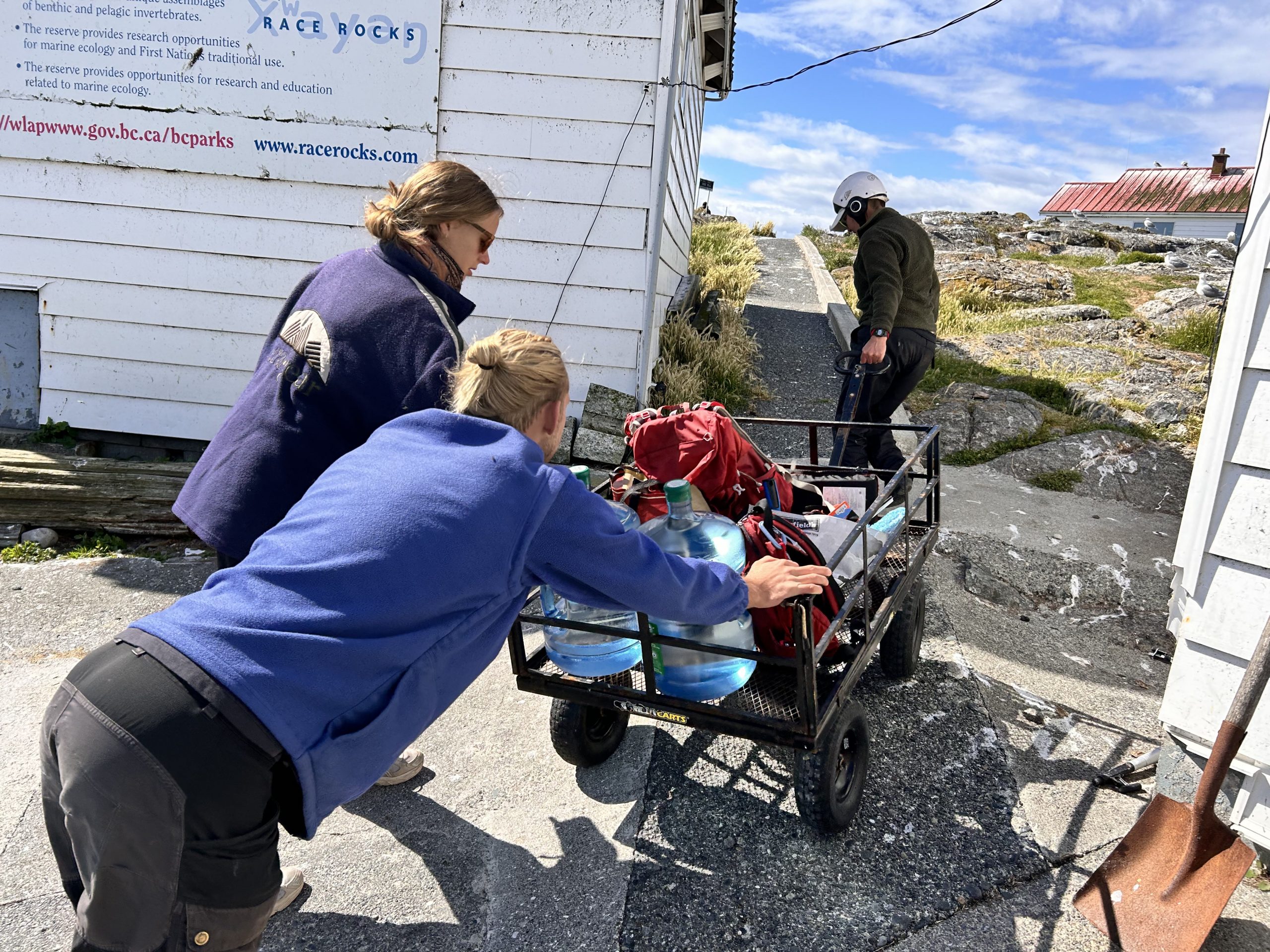 Supplies for the Ecoguardian are off-loaded
Supplies for the Ecoguardian are off-loaded
- Sea lion fence
- For several years now we have mainytained a sealion fence to keep the sealions out of the central island area where they can cause damage to infrastructure . This year, I submitted an application to BC Parks for funding to pay for installation of a permanent fenceline as the temporary posts are often pushed over by the sealions when they accumulate in the fall in massive numbers on the archipelago of islands
- This year there has been an invasion of the grass foxtail over much of the island
- It has almost totally replaced the pineapple weed which has been abundant in previous years
- one of the many Ecotourism boats passes through the channel North of the docks
- James and Ann documented nests and locations on the island
- Most nests have some eggs
- The Glaucous-winged gull
- Glaucous winged and the western xglaucous -winged hybrid
- a barn swallows nest has appeared although there were no birds in sight
- A lone cormorant on the south side of great Race Island
- Ann Nightingale came out to do a proper survey of the Gull population with Andrew Jacobs of the Rocky Point Bird Observatory
- Various invasive polants grow in the compost bin
When I was teaching at Pearson College, we often monitored a set of tidepools out on the island’s West side. I checked out those pools again and took photos which show the state of algae growth. Some observations in the tidepool files provide a baseline for comparative studies in the future. These files are on the tidepools
Today’s observations are in the set of photos below
- Tidelpool#1
- tidelpool#2
- tidelpool#3
- tidelpool#4
- tidelpool#5
- tidelpool#6
- tidepool#7
- tidepool8
- tidelpool#9
- tidelpool#10
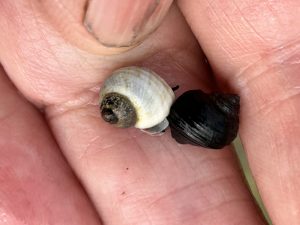 I checked pool #4 which has a white quartz intrusion through it to see if the white periwinkle snails were still there.
I checked pool #4 which has a white quartz intrusion through it to see if the white periwinkle snails were still there.
A review of some of the installations on the Island
- Always a problem is the growth of Algae on the buildings. The Ecoguardians play a big role in trying to keep up with this problem and it involves scrubbing and hosing down.
- The latest version of composting toilet has proven to be very effective.
- Newly added Solar panels provide effective production of energy to run the island in the summer months I hope we can get the red goghorn bells repainted soon . They were te last air chime s to be in service in North America
- I checked on the Davis weather instrument as there have been some erroneous readings of the rain guage tis spring. All seemed to be functioning normally at this end.
- Greg gives instruction on the runneiing of equipment in the engine room to James.
- Keeping the storage cells at the right capacity is important, so detailed instruction is given to all new Ecoguardians
- This year there has been an invasion of the grass foxtail over much of the island
- It has almost totally replaced the pineapple weed which has been abundant in previous years
- This male elephant seal has taken up residence on the island and doent seem to be botthered by the foxtail
- one of the many Ecotourism boats passes through the channel North of the docks
Due to recent notices on social media about the problems that pet owners are having when their dogs get exposed to foxtail , I was concerned about whether there was a similar problem with marine mammals. This guy certainly seems to be enjoying the location however.
I tried to find the small patch of the rare plant seaside plant Romanzoffia on the rocks on the East side of the house. Unfortunately the area was covered with knotweed now. We will have to check again in the winter.
- Knotweed
The Turkish marsh gladiolus is now in bloom. This is a good example of a garden escape, planted by lighthouse keepers probably as much as 80 years ago, they still come up every summer .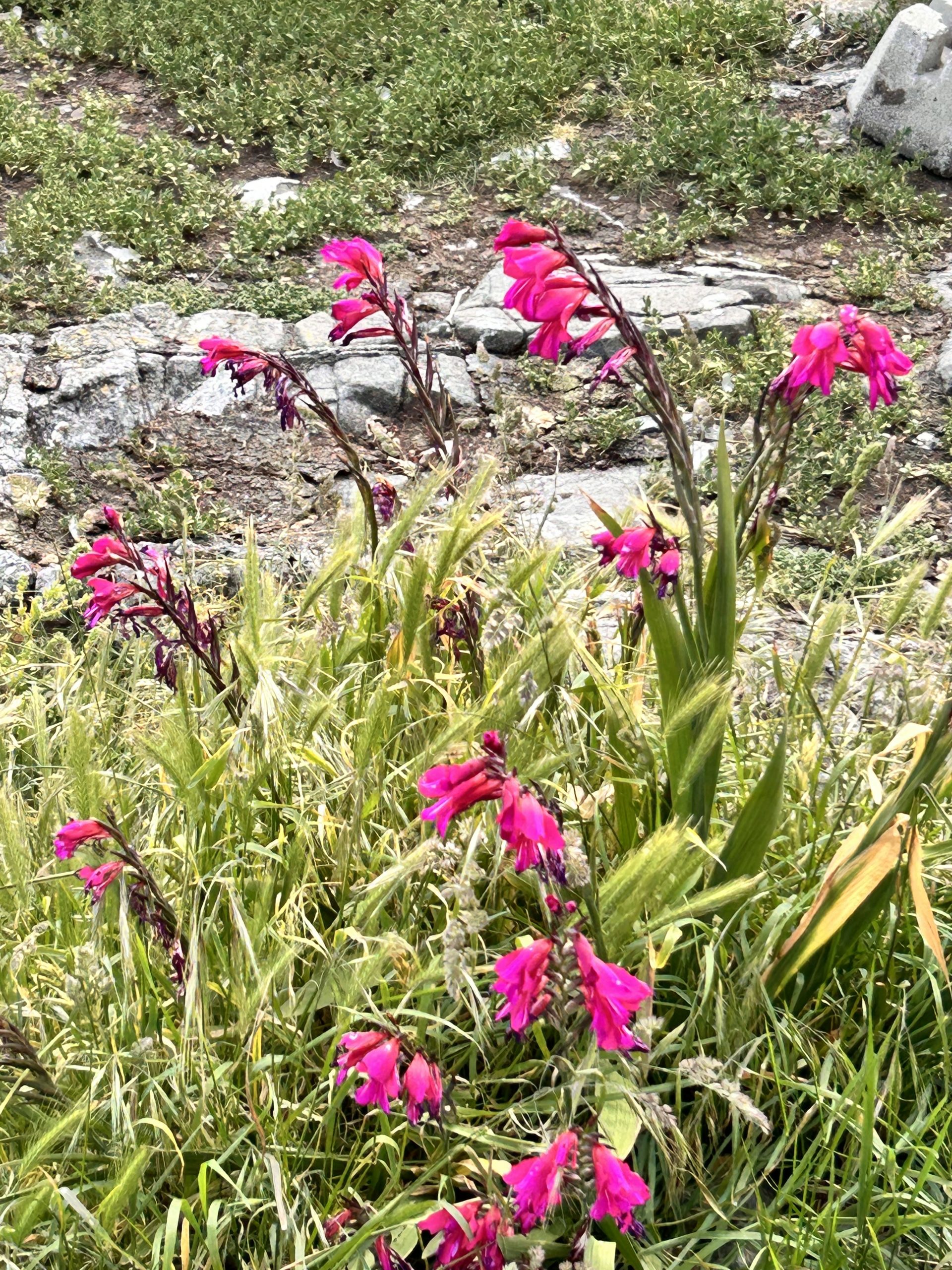
E-Bird June Race Rocks gull survey and Census
E-Bird Gull Survey https://ebird.org/checklist/S184107190
Subject: June Racerocks Gull Survey



